Your source for the latest news on yachts, boats and more. Read through our articles to find out how to compare boats and find the right fit for you!

The best catamarans for ocean sailing/crossing
Sep 25, 2020
less than a min
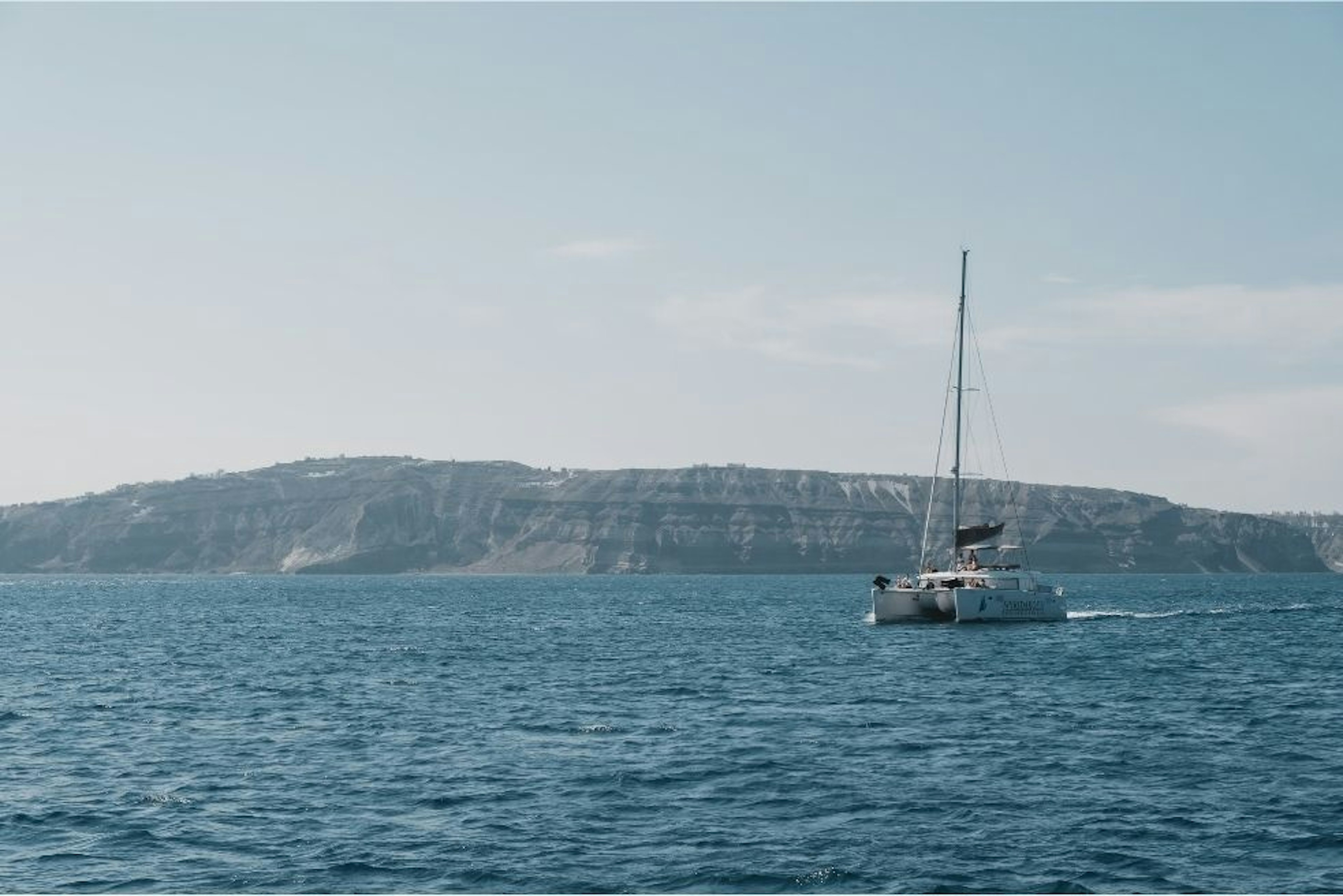
The best catamarans for ocean crossing have to embody a few key features in order to be safe for anyone on board, including guests and crew members. Most catamarans do perform quite well in open waters and are regarded as safe vessels to be offshore. This is especially true with large catamarans with big hulls.
In addition, many catamarans have sailed through horrific weather and have managed not to capsize due to their great roll inertia. What basically happens to a catamaran in a rough sea is the boat just surfs sideways when a big wave hits.
Not to worry however as in most cases, weather forecasts will determine whether a catamaran can go offshore on that specific day or not. In addition, the highest risks are when catamarans sail on a north- south axis between seasons. That said, there are a few catamarans that do perform better when crossing oceans than others.
Typically, cruising catamarans are divided into two categories:
- Charter Catamarans
- High-Performance Cruising Catamarans
Charter catamarans have fixed keels, shorter bows, forward masts, heavier displacement, high-windage flybridges, and low-aspect rudders. These boats are mainly chartered to guests and are not designed for ocean crossing rather than sailing close to shore and enjoying views in a touristic way.
High-performance cruising catamarans , on the other hand, have deeper rudders, less displacement, efficient daggerboards, a small weight and large sail plans. They are able to go at a 50-degree TWA to windward in all weather conditions, and can even outsail keelboats. In addition, when a storm hits, all that is needed is for the catamaran to sail at a higher speed and maintain balance and lower loads.
These features make them some of the best catamarans for ocean sailing.
Which is the best catamaran for ocean sailing
After getting a quick glance of what makes a multihull a good fit for offshore sailing, let’s get to the good part: which one is the best catamaran for ocean cruising ?
Technically, there are thousands of options to choose from when it comes to catamarans. So today we are going to present our choice based on the criteria mentioned above.
One of the best catamarans for ocean sailing in 2020 is The Privilege 435 . This is a long-distance, light weight cruiser produced in the Gold Coast area of La Rochelle. The Privilege 435 is a heavy-displacement multihull that has been around for almost 30 years. This is a luxurious well-built yacht with a decent proportion that allows it to cross oceans safely. It has a 23ft 2in beam, 43ft 1in LOA, as well as good proportion with a low-slung superstructure which is perfect for low wind resistance. In addition, the Privilege 435 is equipped with 4 cabins and 4 showers and costs about $300,000 to $350,000. The ample interior makes for a comfortable vessel to withstand long- distance trips.
While this catamaran sits on the high-end of the spectrum when it comes to yachts, there are many other more affordable options to choose from, if you are looking to sail offshore on a long-distance trip. Use TheBoatDB with a free account to compare other catamarans to the Privilege435 and figure out which one is the best fit for you to ocean cruise. You can even browse through TheBoatDB database to get some more options on the table. Last but not least, make sure to take into account the route and predicted weather conditions before embarking on your adventure.
You might like these too

Sailboat or Motorboat – Learn the pros and cons lg ...
Aug 24, 2022

Types of Catamaran Boats: Sailing, Power, and Luxury Catamarans lg ...
Feb 10, 2023

Which is better a wooden boat or fiberglass boat lg ...

What are the main types of sail rigs for sailboats lg ...

Which is the Best Economical Catamaran lg ...
Oct 04, 2021

What is a Chine on a Boat lg ...
Oct 01, 2021
- Yachting World
- Digital Edition

43 of the best bluewater sailboat designs of all time
- January 5, 2022
How do you choose the right yacht for you? We highlight the very best bluewater sailboat designs for every type of cruising

Which yacht is the best for bluewater boating? This question generates even more debate among sailors than questions about what’s the coolest yacht , or the best for racing. Whereas racing designs are measured against each other, cruising sailors get very limited opportunities to experience different yachts in real oceangoing conditions, so what is the best bluewater sailboat?
Here, we bring you our top choices from decades of designs and launches. Over the years, the Yachting World team has sailed these boats, tested them or judged them for European Yacht of the Year awards, and we have sifted through the many to curate a selection that we believe should be on your wishlist.
Making the right choice may come down to how you foresee your yacht being used after it has crossed an ocean or completed a passage: will you be living at anchor or cruising along the coast? If so, your guiding requirements will be space, cabin size, ease of launching a tender and anchoring closer to shore, and whether it can comfortably accommodate non-expert-sailor guests.
Article continues below…

The perfect boat: what makes an ideal offshore cruising yacht?
Choosing a boat for offshore cruising is not a decision to be taken lightly. I have researched this topic on…

European Yacht of the Year 2019: Best luxury cruisers
Before the sea trials began, I would have put money on a Hallberg-Rassy or the Wauquiez winning an award. The…
All of these considerations have generated the inexorable rise of the bluewater catamaran – monohulls can’t easily compete on these points. We have a full separate feature on the best bluewater multihulls of all time and here we mostly focus on monohulls. The only exceptions to that rule are two multihulls which made it into our best bluewater sailboats of 2022 list.
As so much of making the right choice is selecting the right boat for the venture in mind, we have separated out our edit into categories: best for comfort; for families; for performance; and for expedition or high latitudes sailing .
Best bluewater sailboats of 2022
The new flagship Allures 51.9, for example, is a no-nonsense adventure cruising design built and finished to a high standard. It retains Allures’ niche of using aluminium hulls with glassfibre decks and superstructures, which, the yard maintains, gives the optimum combination of least maintenance and less weight higher up. Priorities for this design were a full beam aft cabin and a spacious, long cockpit. Both are excellent, with the latter, at 6m long, offering formidable social, sailing and aft deck zones.
It likes some breeze to come to life on the wheel, but I appreciate that it’s designed to take up to five tonnes payload. And I like the ease with which you can change gears using the furling headsails and the positioning of the powerful Andersen winches inboard. The arch is standard and comes with a textile sprayhood or hard bimini.
Below decks you’ll find abundant headroom and natural light, a deep U-shape galley and cavernous stowage. For those who like the layout of the Amel 50 but would prefer aluminium or shoal draught, look no further.
Allures 51.9 price: €766,000
The Ovni 370 is another cunning new aluminum centreboard offering, a true deck saloon cruiser for two. The designers say the biggest challenge was to create a Category A ocean going yacht at this size with a lifting keel, hence the hull had to be very stable.
Enjoyable to helm, it has a practical, deep cockpit behind a large sprayhood, which can link to the bimini on the arch. Many of its most appealing features lie in the bright, light, contemporary, clever, voluminous interior, which has good stowage and tankage allocation. There’s also a practical navstation, a large workroom and a vast separate shower. I particularly like the convertible saloom, which can double as a large secure daybed or pilot berth.
Potentially the least expensive Category A lift keel boat available, the Ovni will get you dreaming of remote places again.
Ovni 370 price: €282,080

There’s no shortage of spirit in the Windelo 50. We gave this a sustainability award after it’s founders spent two years researching environmentally-friendly composite materials, developing an eco-composite of basalt fibre and recycled PET foam so it could build boats that halve the environmental impact of standard glassfibre yachts.
The Windelo 50 is an intriguing package – from the styling, modular interior and novel layout to the solar field on the roof and the standard electric propulsion, it is completely fresh.
Windelo 50 price: €795,000
Best bluewater sailboat of 2022 – Outremer 55
I would argue that this is the most successful new production yacht on the market. Well over 50 have already sold (an equipped model typically costs €1.6m) – and I can understand why. After all, were money no object, I had this design earmarked as the new yacht I would most likely choose for a world trip.
Indeed 55 number one Sanya, was fully equipped for a family’s world cruise, and left during our stay for the Grand Large Odyssey tour. Whereas we sailed Magic Kili, which was tricked up with performance options, including foam-cored deckheads and supports, carbon crossbeam and bulkheads, and synthetic rigging.
At rest, these are enticing space ships. Taking one out to sea is another matter though. These are speed machines with the size, scale and loads to be rightly weary of. Last month Nikki Henderson wrote a feature for us about how to manage a new breed of performance cruising cats just like this and how she coaches new owners. I could not think of wiser money spent for those who do not have ample multihull sailing experience.
Under sail, the most fun was obviously reserved for the reaching leg under asymmetric, where we clocked between 11-16 knots in 15-16 knots wind. But it was the stability and of those sustained low teen speeds which really hit home – passagemaking where you really cover miles.
Key features include the swing helms, which give you views from outboard, over the coachroof or from a protected position in the cockpit through the coachroof windows, and the vast island in the galley, which is key to an open plan main living area. It helps provide cavernous stowage and acts as the heart of the entertaining space as it would in a modern home. As Danish judge Morten Brandt-Rasmussen comments: “Apart from being the TGV of ocean passages the boat offers the most spacious, open and best integration of the cockpit and salon areas in the market.”
Outremer has done a top job in packing in the creature comforts, stowage space and payload capacity, while keeping it light enough to eat miles. Although a lot to absorb and handle, the 55 offers a formidable blend of speed and luxury cruising.
Outremer 55 price: €1.35m
Best bluewater sailboats for comfort
This is the successor to the legendary Super Maramu, a ketch design that for several decades defined easy downwind handling and fostered a cult following for the French yard. Nearly a decade old, the Amel 55 is the bridge between those world-girdling stalwarts and Amel’s more recent and totally re-imagined sloop designs, the Amel 50 and 60.
The 55 boasts all the serious features Amel aficionados loved and valued: a skeg-hung rudder, solidly built hull, watertight bulkheads, solid guardrails and rampart bulwarks. And, most noticeable, the solid doghouse in which the helmsman sits in perfect shelter at the wheel.
This is a design to live on comfortably for long periods and the list of standard features just goes on and on: passarelle; proper sea berths with lee cloths; electric furling main and genoa; and a multitude of practical items that go right down to a dishwasher and crockery.
There’s no getting around the fact these designs do look rather dated now, and through the development of easier sail handling systems the ketch rig has fallen out of fashion, but the Amel is nothing short of a phenomenon, and if you’ve never even peeked on board one, you really have missed a treat.

Photo: Sander van der Borch
Contest 50CS
A centre cockpit cruiser with true longevity, the Contest 50CS was launched by Conyplex back in 2003 and is still being built by the family-owned Dutch company, now in updated and restyled form.
With a fully balanced rudder, large wheel and modern underwater sections, the Contest 50CS is a surprisingly good performer for a boat that has a dry weight of 17.5 tonnes. Many were fitted with in-mast furling, which clearly curtails that performance, but even without, this boat is set up for a small crew.
Electric winches and mainsheet traveller are all easy to reach from the helm. On our test of the Contest 50CS, we saw for ourselves how two people can gybe downwind under spinnaker without undue drama. Upwind, a 105% genoa is so easy to tack it flatters even the weediest crewmember.
Down below, the finish level of the joinery work is up there among the best and the interior is full of clever touches, again updated and modernised since the early models. Never the cheapest bluewater sailing yacht around, the Contest 50CS has remained in demand as a brokerage buy. She is a reassuringly sure-footed, easily handled, very well built yacht that for all those reasons has stood the test of time.
This is a yacht that would be well capable of helping you extend your cruising grounds, almost without realising it.
Read more about the Contest 50CS and the new Contest 49CS

Photo: Rick Tomlinson
Hallberg-Rassy 48 Mk II
For many, the Swedish Hallberg-Rassy yard makes the quintessential bluewater cruiser for couples. With their distinctive blue cove line, these designs are famous for their seakindly behaviour, solid-as-a-rock build and beautifully finished, traditional interiors.
To some eyes, Hallberg-Rassys aren’t quite cool enough, but it’s been company owner Magnus Rassy’s confidence in the formula and belief in incremental ‘step-by-step’ evolution that has been such an exceptional guarantor of reliable quality, reputation and resale value.
The centre cockpit Hallberg-Rassy 48 epitomises the concept of comfort at sea and, like all the Frers-designed Hallberg-Rassys since the 1990s, is surprisingly fleet upwind as well as steady downwind. The 48 is perfectly able to be handled by a couple (as we found a few years back in the Pacific), and could with no great effort crack out 200-mile days.
The Hallberg-Rassy 48 was launched nearly a decade ago, but the Mk II from 2014 is our pick, updated with a more modern profile, larger windows and hull portlights that flood the saloon and aft cabin with light. With a large chart table, secure linear galley, heaps of stowage and space for bluewater extras such as machinery and gear, this yacht pretty much ticks all the boxes.

Discovery 55
First launched in 2000, the Discovery 55 has stood the test of time. Designed by Ron Holland, it hit a sweet spot in size that appealed to couples and families with world girdling plans.
Elegantly styled and well balanced, the 55 is also a practical design, with a deep and secure cockpit, comfortable seating, a self-tacking jib, dedicated stowage for the liferaft , a decent sugar scoop transom that’s useful for swimming or dinghy access, and very comfortable accommodation below. In short, it is a design that has been well thought out by those who’ve been there, got the bruises, stubbed their toes and vowed to change things in the future if they ever got the chance.
Throughout the accommodation there are plenty of examples of good detailing, from the proliferation of handholds and grabrails, to deep sinks in the galley offering immediate stowage when under way and the stand up/sit down showers. Stowage is good, too, with plenty of sensibly sized lockers in easily accessible positions.
The Discovery 55 has practical ideas and nifty details aplenty. She’s not, and never was, a breakthrough in modern luxury cruising but she is pretty, comfortable to sail and live on, and well mannered.

Photo: Latitudes Picture Library
You can’t get much more Cornish than a Rustler. The hulls of this Stephen Jones design are hand-moulded and fitted out in Falmouth – and few are more ruggedly built than this traditional, up-for-anything offshore cruiser.
She boasts an encapsulated lead keel, eliminating keel bolts and creating a sump for generous fuel and water tankage, while a chunky skeg protects the rudder. She is designed for good directional stability and load carrying ability. These are all features that lend this yacht confidence as it shoulders aside the rough stuff.
Most of those built have had a cutter rig, a flexible arrangement that makes sense for long passages in all sea and weather conditions. Down below, the galley and saloon berths are comfortable and sensible for living in port and at sea, with joinery that Rustler’s builders are rightly proud of.
As modern yachts have got wider, higher and fatter, the Rustler 42 is an exception. This is an exceptionally well-mannered seagoing yacht in the traditional vein, with elegant lines and pleasing overhangs, yet also surprisingly powerful. And although now over 20 years old, timeless looks and qualities mean this design makes her look ever more like a perennial, a modern classic.
The definitive crossover size, the point at which a yacht can be handled by a couple but is just large enough to have a professional skipper and be chartered, sits at around the 60ft mark. At 58ft 8in, the Oyster 575 fitted perfectly into this growing market when launched in 2010. It went on to be one of the most popular models from the yard, and is only now being superseded by the newer Rob Humphreys-designed Oyster 565 (just launched this spring).
Built in various configurations with either a deep keel, shoal draught keel or centreboard with twin rudders, owners could trade off better performance against easy access to shallower coves and anchorages. The deep-bodied hull, also by Rob Humphreys, is known for its easy motion at sea.
Some of the Oyster 575’s best features include its hallmark coachroof windows style and centre cockpit – almost everyone will know at first glance this is an Oyster – and superb interior finish. If she has a flaw, it is arguably the high cockpit, but the flip side is the galley headroom and passageway berth to the large aft stateroom.
This design also has a host of practical features for long-distance cruising, such as high guardrails, dedicated liferaft stowage, a vast lazarette for swallowing sails, tender, fenders etc, and a penthouse engine room.

Privilege Serie 5
A true luxury catamaran which, fully fitted out, will top €1m, this deserves to be seen alongside the likes of the Oyster 575, Gunfleet 58 and Hallberg-Rassy 55. It boasts a large cockpit and living area, and a light and spacious saloon with an emphasis on indoor-outdoor living, masses of refrigeration and a big galley.
Standout features are finish quality and solid build in a yacht designed to take a high payload, a secure walkaround deck and all-round views from the helm station. The new Privilege 510 that will replace this launches in February 2020.
Gunfleet 43
It was with this Tony Castro design that Richard Matthews, founder of Oyster Yachts, launched a brand new rival brand in 2012, the smallest of a range stretching to the flagship Gunfleet 74. The combination of short overhangs and centre cockpit at this size do make the Gunfleet 43 look modern if a little boxy, but time and subsequent design trends have been kind to her lines, and the build quality is excellent. The saloon, galley and aft cabin space is exceptional on a yacht of this size.

Photo: David Harding
Conceived as a belt-and-braces cruiser, the Kraken 50 launched last year. Its unique points lie underwater in the guise of a full skeg-hung rudder and so-called ‘Zero Keel’, an encapsulated long keel with lead ballast.
Kraken Yachts is the brainchild of British businessman and highly experienced cruiser Dick Beaumont, who is adamant that safety should be foremost in cruising yacht design and build. “There is no such thing as ‘one yacht for all purposes’… You cannot have the best of all worlds, whatever the salesman tells you,” he says.
Read our full review of the Kraken 50 .

Wauquiez Centurion 57
Few yachts can claim to be both an exciting Med-style design and a serious and practical northern European offshore cruiser, but the Wauquiez Centurion 57 tries to blend both. She slightly misses if you judge solely by either criterion, but is pretty and practical enough to suit her purpose.
A very pleasant, well-considered yacht, she is impressively built and finished with a warm and comfortable interior. More versatile than radical, she could be used for sailing across the Atlantic in comfort and raced with equal enjoyment at Antigua Sailing Week .

A modern classic if ever there was one. A medium to heavy displacement yacht, stiff and easily capable of standing up to her canvas. Pretty, traditional lines and layout below.

Photo: Voyage of Swell
Well-proven US legacy design dating back to the mid-1960s that once conquered the Transpac Race . Still admired as pretty, with slight spoon bow and overhanging transom.

Capable medium displacement cruiser, ideal size and good accommodation for couples or family cruising, and much less costly than similar luxury brands.

Photo: Peter Szamer
Swedish-built aft cockpit cruiser, smaller than many here, but a well-built and finished, super-durable pocket ocean cruiser.

Tartan 3700
Designed as a performance cruiser there are nimbler alternatives now, but this is still an extremely pretty yacht.
Broker ’ s choice

Discovery 55 Brizo
This yacht has already circumnavigated the globe and is ‘prepared for her next adventure,’ says broker Berthon. Price: £535,000 + VAT

Oyster 575 Ayesha
‘Stunning, and perfectly equipped for bluewater cruising,’ says broker Ancasta International. Price: £845,000 (tax not paid)

Oyster 575 Pearls of Nautilus
Nearly new and with a high spec, this Oyster Brokerage yacht features American white oak joinery and white leather upholstery and has a shoal draught keel. Price: $1.49m
Best bluewater yachts for performance
The Frers-designed Swan 54 may not be the newest hull shape but heralded Swan’s latest generation of displacement bluewater cruisers when launched four years ago. With raked stem, deep V hull form, lower freeboard and slight curve to the topsides she has a more timeless aesthetic than many modern slab-sided high volume yachts, and with that a seakindly motion in waves. If you plan to cover many miles to weather, this is probably the yacht you want to be on.

Photo: Carlo Borlenghi
Besides Swan’s superlative build quality, the 54 brings many true bluewater features, including a dedicated sail locker. There’s also a cockpit locker that functions as a utility cabin, with potential to hold your generator and washing machine, or be a workshop space.
The sloping transom opens out to reveal a 2.5m bathing platform, and although the cabins are not huge there is copious stowage space. Down below the top-notch oak joinery is well thought through with deep fiddles, and there is a substantial nav station. But the Swan 54 wins for handling above all, with well laid-out sail controls that can be easily managed between a couple, while offering real sailing enjoyment to the helmsman.

Photo: Graham Snook
The Performance Cruiser winner at the 2019 European Yacht of the Year awards, the Arcona 435 is all about the sailing experience. She has genuine potential as a cruiser-racer, but her strengths are as an enjoyable cruiser rather than a full-blown liveaboard bluewater boat.
Build quality is excellent, there is the option of a carbon hull and deck, and elegant lines and a plumb bow give the Arcona 435 good looks as well as excellent performance in light airs. Besides slick sail handling systems, there are well thought-out features for cruising, such as ample built-in rope bins and an optional semi-closed stern with stowage and swim platform.

Outremer 51
If you want the space and stability of a cat but still prioritise sailing performance, Outremer has built a reputation on building catamarans with true bluewater characteristics that have cruised the planet for the past 30 years.
Lighter and slimmer-hulled than most cruising cats, the Outremer 51 is all about sailing at faster speeds, more easily. The lower volume hulls and higher bridgedeck make for a better motion in waves, while owners report that being able to maintain a decent pace even under reduced canvas makes for stress-free passages. Deep daggerboards also give good upwind performance.
With bucket seats and tiller steering options, the Outremer 51 rewards sailors who want to spend time steering, while they’re famously well set up for handling with one person on deck. The compromise comes with the interior space – even with a relatively minimalist style, there is less cabin space and stowage volume than on the bulkier cats, but the Outremer 51 still packs in plenty of practical features.

The Xc45 was the first cruising yacht X-Yachts ever built, and designed to give the same X-Yachts sailing experience for sailors who’d spent years racing 30/40-footer X- and IMX designs, but in a cruising package.
Launched over 10 years ago, the Xc45 has been revisited a few times to increase the stowage and modernise some of the styling, but the key features remain the same, including substantial tanks set low for a low centre of gravity, and X-Yachts’ trademark steel keel grid structure. She has fairly traditional styling and layout, matched with solid build quality.
A soft bilge and V-shaped hull gives a kindly motion in waves, and the cockpit is secure, if narrow by modern standards.

A three or four cabin catamaran that’s fleet of foot with high bridgedeck clearance for comfortable motion at sea. With tall daggerboards and carbon construction in some high load areas, Catana cats are light and quick to accelerate.

Sweden Yachts 45
An established bluewater design that also features in plenty of offshore races. Some examples are specced with carbon rig and retractable bowsprits. All have a self-tacking jib for ease. Expect sweeping areas of teak above decks and a traditionally wooded interior with hanging wet locker.

A vintage performer, first launched in 1981, the 51 was the first Frers-designed Swan and marked a new era of iconic cruiser-racers. Some 36 of the Swan 51 were built, many still actively racing and cruising nearly 40 years on. Classic lines and a split cockpit make this a boat for helming, not sunbathing.

Photo: Julien Girardot / EYOTY
The JPK 45 comes from a French racing stable, combining race-winning design heritage with cruising amenities. What you see is what you get – there are no superfluous headliners or floorboards, but there are plenty of ocean sailing details, like inboard winches for safe trimming. The JPK 45 also has a brilliantly designed cockpit with an optional doghouse creating all-weather shelter, twin wheels and superb clutch and rope bin arrangement.

Photo: Andreas Lindlahr
For sailors who don’t mind exchanging a few creature comforts for downwind planing performance, the Pogo 50 offers double-digit surfing speeds for exhilarating tradewind sailing. There’s an open transom, tiller steering and no backstay or runners. The Pogo 50 also has a swing keel, to nose into shallow anchorages.

Seawind 1600
Seawinds are relatively unknown in Europe, but these bluewater cats are very popular in Australia. As would be expected from a Reichel-Pugh design, this 52-footer combines striking good looks and high performance, with fine entry bows and comparatively low freeboard. Rudders are foam cored lifting designs in cassettes, which offer straightforward access in case of repairs, while daggerboards are housed under the deck.
Best bluewater sailboats for families
It’s unsurprising that, for many families, it’s a catamaran that meets their requirements best of increased space – both living space and separate cabins for privacy-seeking teenagers, additional crew or visiting family – as well as stable and predictable handling.

Photo: Nicholas Claris
Undoubtedly one of the biggest success stories has been the Lagoon 450, which, together with boats like the Fountaine Pajot 44, helped drive up the popularity of catamaran cruising by making it affordable and accessible. They have sold in huge numbers – over 1,000 Lagoon 450s have been built since its launch in 2010.
The VPLP-designed 450 was originally launched with a flybridge with a near central helming position and upper level lounging areas (450F). The later ‘sport top’ option (450S) offered a starboard helm station and lower boom (and hence lower centre of gravity for reduced pitching). The 450S also gained a hull chine to create additional volume above the waterline. The Lagoon features forward lounging and aft cockpit areas for additional outdoor living space.
Besides being a big hit among charter operators, Lagoons have proven themselves over thousands of bluewater miles – there were seven Lagoon 450s in last year’s ARC alone. In what remains a competitive sector of the market, Lagoon has recently launched a new 46, with a larger self-tacking jib and mast moved aft, and more lounging areas.

Photo: Gilles Martin-Raget
Fountaine Pajot Helia 44
The FP Helia 44 is lighter, lower volume, and has a lower freeboard than the Lagoon, weighing in at 10.8 tonnes unloaded (compared to 15 for the 450). The helm station is on a mezzanine level two steps up from the bridgedeck, with a bench seat behind. A later ‘Evolution’ version was designed for liveaboard cruisers, featuring beefed up dinghy davits and an improved saloon space.
Available in three or four cabin layouts, the Helia 44 was also popular with charter owners as well as families. The new 45 promises additional volume, and an optional hydraulically lowered ‘beach club’ swim platform.

Photo: Arnaud De Buyzer / graphikup.com
The French RM 1370 might be less well known than the big brand names, but offers something a little bit different for anyone who wants a relatively voluminous cruising yacht. Designed by Marc Lombard, and beautifully built from plywood/epoxy, the RM is stiff and responsive, and sails superbly.
The RM yachts have a more individual look – in part down to the painted finish, which encourages many owners to personalise their yachts, but also thanks to their distinctive lines with reverse sheer and dreadnought bow. The cockpit is well laid out with the primary winches inboard for a secure trimming position. The interior is light, airy and modern, although the open transom won’t appeal to everyone.
For those wanting a monohull, the Hanse 575 hits a similar sweet spot to the popular multis, maximising accommodation for a realistic price, yet with responsive performance.
The Hanse offers a vast amount of living space thanks to the ‘loft design’ concept of having all the living areas on a single level, which gives a real feeling of spaciousness with no raised saloon or steps to accommodation. The trade-off for such lofty head height is a substantial freeboard – it towers above the pontoon, while, below, a stepladder is provided to reach some hatches.
Galley options include drawer fridge-freezers, microwave and coffee machine, and the full size nav station can double up as an office or study space.
But while the Hanse 575 is a seriously large boat, its popularity is also down to the fact that it is genuinely able to be handled by a couple. It was innovative in its deck layout: with a self-tacking jib and mainsheet winches immediately to hand next to the helm, one person could both steer and trim.
Direct steering gives a feeling of control and some tangible sailing fun, while the waterline length makes for rapid passage times. In 2016 the German yard launched the newer Hanse 588 model, having already sold 175 of the 575s in just four years.

Photo: Bertel Kolthof
Jeanneau 54
Jeanneau leads the way among production builders for versatile all-rounder yachts that balance sail performance and handling, ergonomics, liveaboard functionality and good looks. The Jeanneau 54 , part of the range designed by Philippe Briand with interior by Andrew Winch, melds the best of the larger and smaller models and is available in a vast array of layout options from two cabins/two heads right up to five cabins and three heads.
We’ve tested the Jeanneau 54 in a gale and very light winds, and it acquitted itself handsomely in both extremes. The primary and mainsheet winches are to hand next to the wheel, and the cockpit is spacious, protected and child-friendly. An electric folding swim and sun deck makes for quick fun in the water.

Nautitech Open 46
This was the first Nautitech catamaran to be built under the ownership of Bavaria, designed with an open-plan bridgedeck and cockpit for free-flowing living space. But with good pace for eating up bluewater miles, and aft twin helms rather than a flybridge, the Nautitech Open 46 also appeals to monohull sailors who prefer a more direct sailing experience.

Made by Robertson and Caine, who produce catamarans under a dual identity as both Leopard and the Sunsail/Moorings charter cats, the Leopard 45 is set to be another big seller. Reflecting its charter DNA, the Leopard 45 is voluminous, with stepped hulls for reduced waterline, and a separate forward cockpit.
Built in South Africa, they are robustly tested off the Cape and constructed ruggedly enough to handle heavy weather sailing as well as the demands of chartering.

Photo: Olivier Blanchet
If space is king then three hulls might be even better than two. The Neel 51 is rare as a cruising trimaran with enough space for proper liveaboard sailing. The galley and saloon are in the large central hull, together with an owner’s cabin on one level for a unique sensation of living above the water. Guest or family cabins lie in the outer hulls for privacy and there is a cavernous full height engine room under the cabin sole.
Performance is notably higher than an equivalent cruising cat, particularly in light winds, with a single rudder giving a truly direct feel in the helm, although manoeuvring a 50ft trimaran may daunt many sailors.

Beneteau Oceanis 46.1
A brilliant new model from Beneteau, this Finot Conq design has a modern stepped hull, which offers exhilarating and confidence-inspiring handling in big breezes, and slippery performance in lighter winds.
The Beneteau Oceanis 46.1 was the standout performer at this year’s European Yacht of the Year awards, and, in replacing the popular Oceanis 45, looks set to be another bestseller. Interior space is well used with a double island berth in the forepeak. An additional inboard unit creates a secure galley area, but tank capacity is moderate for long periods aboard.

Beneteau Oceanis 473
A popular model that offers beam and height in a functional layout, although, as with many boats of this age (she was launched in 2002), the mainsheet is not within reach of the helmsman.

Jeanneau Sun Odyssey 49
The Philippe Briand-designed Sun Odyssey range has a solid reputation as family production cruisers. Like the 473, the Sun Odyssey 49 was popular for charter so there are plenty of four-cabin models on the market.

Nautitech 441
The hull design dates back to 1995, but was relaunched in 2012. Though the saloon interior has dated, the 441 has solid practical features, such as a rainwater run-off collection gutter around the coachroof.

Atlantic 42
Chris White-designed cats feature a pilothouse and forward waist-high working cockpit with helm position, as well as an inside wheel at the nav station. The Atlantic 42 offers limited accommodation by modern cat standards but a very different sailing experience.
Best bluewater sailing yachts for expeditions
Bestevaer 56.
All of the yachts in our ‘expedition’ category are aluminium-hulled designs suitable for high latitude sailing, and all are exceptional yachts. But the Bestevaer 56 is a spectacular amount of boat to take on a true adventure. Each Bestevaer is a near-custom build with plenty of bespoke options for owners to customise the layout and where they fall on the scale of rugged off-grid adventurer to 4×4-style luxury fit out.

The Bestevaer range began when renowned naval architect Gerard Dijkstra chose to design his own personal yacht for liveaboard adventure cruising, a 53-footer. The concept drew plenty of interest from bluewater sailors wanting to make longer expeditions and Bestevaers are now available in a range of sizes, with the 56-footer proving a popular mid-range length.
The well-known Bestevaer 56 Tranquilo (pictured above) has a deep, secure cockpit, voluminous tanks (700lt water and over 1,100lt fuel) and a lifting keel plus water ballast, with classically styled teak clad decks and pilot house. Other owners have opted for functional bare aluminium hull and deck, some choose a doghouse and others a pilothouse.

Photo: Jean-Marie Liot
The Boreal 52 also offers Land Rover-esque practicality, with utilitarian bare aluminium hulls and a distinctive double-level doghouse/coachroof arrangement for added protection in all weathers. The cockpit is clean and uncluttered, thanks to the mainsheet position on top of the doghouse, although for visibility in close manoeuvring the helmsman will want to step up onto the aft deck.
Twin daggerboards, a lifting centreboard and long skeg on which she can settle make this a true go-anywhere expedition yacht. The metres of chain required for adventurous anchoring is stowed in a special locker by the mast to keep the weight central. Down below has been thought through with equally practical touches, including plenty of bracing points and lighting that switches on to red light first to protect your night vision.

Photo: Morris Adant / Garcia Yachts
Garcia Exploration 45
The Garcia Exploration 45 comes with real experience behind her – she was created in association with Jimmy Cornell, based on his many hundreds of thousands of miles of bluewater cruising, to go anywhere from high latitudes to the tropics.
Arguably less of a looker than the Bestevaer, the Garcia Exploration 45 features a rounded aluminium hull, centreboard with deep skeg and twin daggerboards. The considerable anchor chain weight has again been brought aft, this time via a special conduit to a watertight locker in front of the centreboard.
This is a yacht designed to be lived on for extended periods with ample storage, and panoramic portlights to give a near 360° view of whichever extraordinary landscape you are exploring. Safety features include a watertight companionway door to keep extreme weather out and through-hull fittings placed above the waterline. When former Vendée Globe skipper Pete Goss went cruising , this was the boat he chose to do it in.

Photo: svnaima.com
A truly well-proven expedition design, some 1,500 Ovnis have been built and many sailed to some of the most far-flung corners of the world. (Jimmy Cornell sailed his Aventura some 30,000 miles, including two Drake Passage crossings, one in 50 knots of wind).

Futuna Exploration 54
Another aluminium design with a swinging centreboard and a solid enclosed pilothouse with protected cockpit area. There’s a chunky bowsprit and substantial transom arch to house all manner of electronics and power generation.
Previous boats have been spec’d for North West Passage crossings with additional heating and engine power, although there’s a carbon rig option for those that want a touch of the black stuff. The tanks are capacious, with 1,000lt capability for both fresh water and fuel.
If you enjoyed this….
Yachting World is the world’s leading magazine for bluewater cruisers and offshore sailors. Every month we have inspirational adventures and practical features to help you realise your sailing dreams. Build your knowledge with a subscription delivered to your door. See our latest offers and save at least 30% off the cover price.
- Outremer 45
- Outremer 4X
- Outremer 4.zero
- Outremer 52
- Outremer 55
- Outremer 51
- Outremer 5X
- All the Outremer Fleet
- Personalized support
- Blue Water Sailing Seminars
- Our concept
- The Outremer team
- Our commitments
- Construction principles
- Our catamaran services
- After-sales customer service & Quality control
- Offshore Connected Catamaran Maintenance
- Concierge Services
- Our owners’ stories
- FAQ – Outremer catamarans

- Brokerage: used catamarans for sale
- Privacy Policy
- Legal Notice
- Grand Large Yatching
Sailing around the world on a catamaran
Setting off around the world in a multihull, perhaps aboard a catamaran… It’s a dream come true! On the trade winds route, in the Atlantic, the Pacific or the Indian Ocean… Let’s discover together, in this article written with Bénédicte, owner of an Outremer 55, the most beautiful round the world stopovers not to be missed.
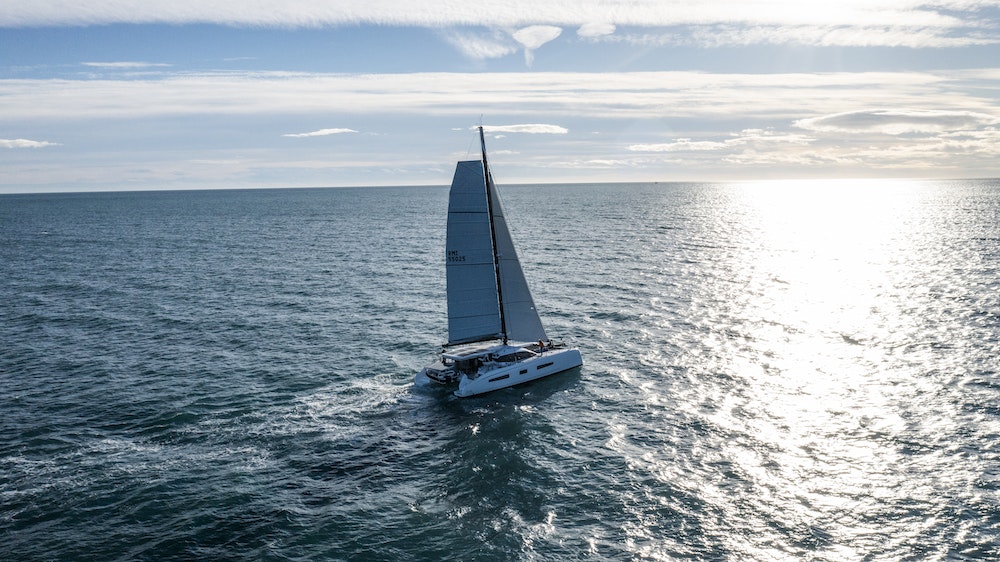
It was the expedition of the Portuguese explorer Magellan in the 16th century that led to the first circumnavigation of the globe under sail. Setting off with five ships in search of a passage between the Atlantic and Pacific oceans, the navigator discovered what would later be known as the Strait of Magellan. The explorer’s reduced squadron continued sailing from east to west around the world, and a single ship completed the circumnavigation. Three years later, he returned to his starting point in Spain and achieved the feat of the first circumnavigation by sailboat.
Even today, sailing around the world is a dream come true. Fortunately for us sailors, today’s conditions are very different and the adventure is much more accessible! It’s now possible to set off on a trip around the world fully equipped. Whatever corner of the globe you find yourself in, you can take advantage of the best instruments to help you navigate and guide you. You’ll also have the luxury of staying connected, so you can check the weather forecast, keep in touch with your loved ones and, above all, stay safe.
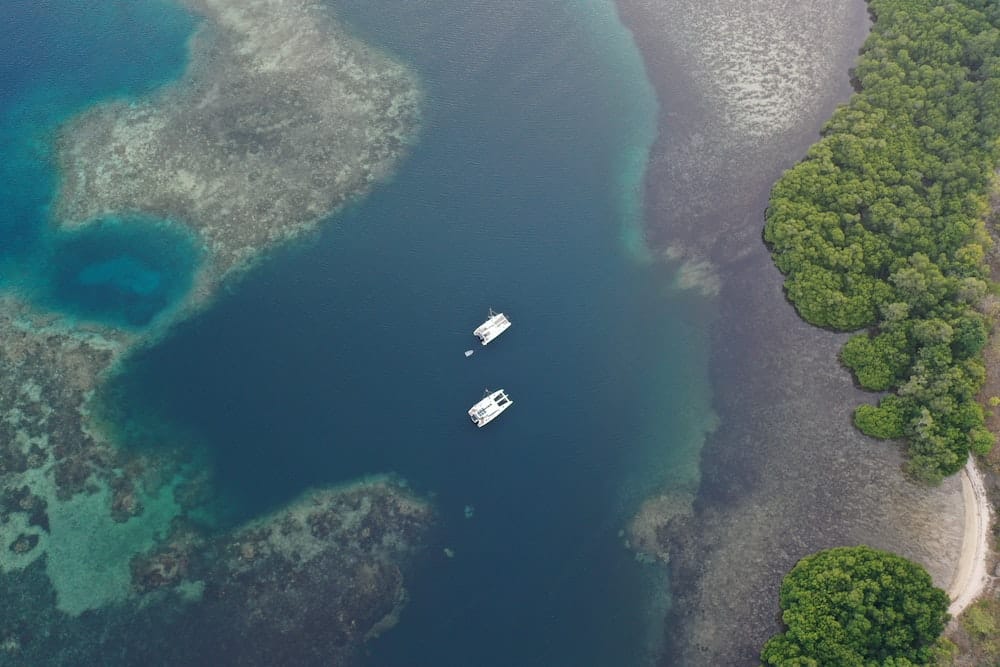
Among multihull owners, Bénédicte Hélies can testify to this! She has been on two round-the-world catamaran voyages with her husband and children, and this is not the first time:
For her first voyage – aboard the Outremer 51 #39 named Moby, the family chose to follow the trade winds. Bénédicte, Loïc, Victor, Arthur and Anna headed for the world’s most famous ports of call, to discover 32 countries and 121 islands. All this in three years and 50,000 nautical miles aboard their catamaran on three oceans: the Atlantic, the Pacific and the Indian.
For their second circumnavigation under sail, this time aboard Saga – l’Outremer 55 #1, the crew is this time opting for new stop-off points, which were not part of the first itinerary. Still sailing from east to west, the family made stops off the beaten track, which they later recounted in the blog Le voyage de Saga .
At the heart of this second adventure, Bénédicte agreed to help us write this article, sharing her best tips for a great catamaran voyage.
Read also: Meet the GLYWO 500 crew: Marijke & Mark on an Outremer 55
Ports of call on a round-the-world sail, on the trade winds route
The Trade Winds route is the classic itinerary followed by most ocean-going catamarans. It promises crews the chance to sail around the world pushed by the wind, downwind, as long as they follow the rhythm of the seasons. It’s possible to sail a catamaran from east to west, crossing three oceans and stopping off at some fantastic destinations.
Leaving Europe, the yachts and their crews generally start by making a transatlantic crossing to the West Indies. They then sail through the Panama Canal to the Pacific Ocean, where they make several stopovers. They then sail, usually via the Torres Strait, to Indonesia and then the Indian Ocean.
From here, there are two ways to reach Europe: via the Suez Canal to the Mediterranean, or around the Cape of Good Hope to the Atlantic. With this second option, crews then generally cross the South Atlantic, followed by a final transatlantic crossing from west to east, in the northern hemisphere.
The first Atlantic legs, from Europe to the West Indies
You will probably start your journey from the Atlantic coast or the Mediterranean Sea. After crossing the Bay of Biscay or the Strait of Gibraltar, you’ll head for the Canary Islands and Cape Verde. Here, you can make your first wonderful discoveries, among friendly people who are used to the passage of voyaging yachts. These destinations are renowned for their sailing sports!
Some crews then stop off in Senegal, where they can also drop off humanitarian supplies taken on board in France. It’s not just a great cruise, it’s also an opportunity to help others…
Then it’s off to the West Indies. After your first transatlantic ocean crossing lasting several weeks, you’ll be able to envisage shorter crossings, between numerous islands that are well worth the diversions. From north to south: the British Virgin Islands, Anguilla, Saint-Martin, Saint-Barthélemy, Antigua, Guadeloupe, Dominica, Martinique, Saint Lucia, Saint-Vincent and the Grenadines, the islands of Trinidad and Tobago… All these destinations promise a sunny end to the year, as well as particularly pleasant sailing conditions. You’re sure to enjoy some exotic experiences!
If you have a little time before passing through the Panama Canal, you could consider sailing to the ABC islands of Aruba, Bonaire and Curaçao, off the coast of Venezuela, which are ideal for water sports. The Cartagena region of Colombia may also be worth a visit.
Finally, before crossing the Panama Canal, the San Blas are a particularly popular destination for tour-dumondist sailors: highly renowned for sailing, the archipelago offers the chance to sail from islet to islet in idyllic landscapes…
In the Pacific Ocean, from the Panama Canal to Australia
After passing through the Panama Canal, you’ll continue to be amazed. A multitude of magnificent destinations await you in the largest ocean on our planet: the Pacific.
After exploring the Pacific coasts of Panama and Costa Rica, the Galapagos archipelago in Ecuador is a comfortable stopover before the trans-Pacific. From there, you can head for the Marquesas Islands and sail through the enormous territory that is French Polynesia, to discover all its riches!
Following in the footsteps of many other sailors, you can stop off in the Tuamotu archipelago, the Windward Islands, the Leeward Islands or, even further afield, the Austral Islands. A word of advice: allow plenty of time to get there, as the distances are great and the destinations are all magnificent… The programme is packed: discover the islands and pearl farming, snorkelling, diving and underwater fishing.
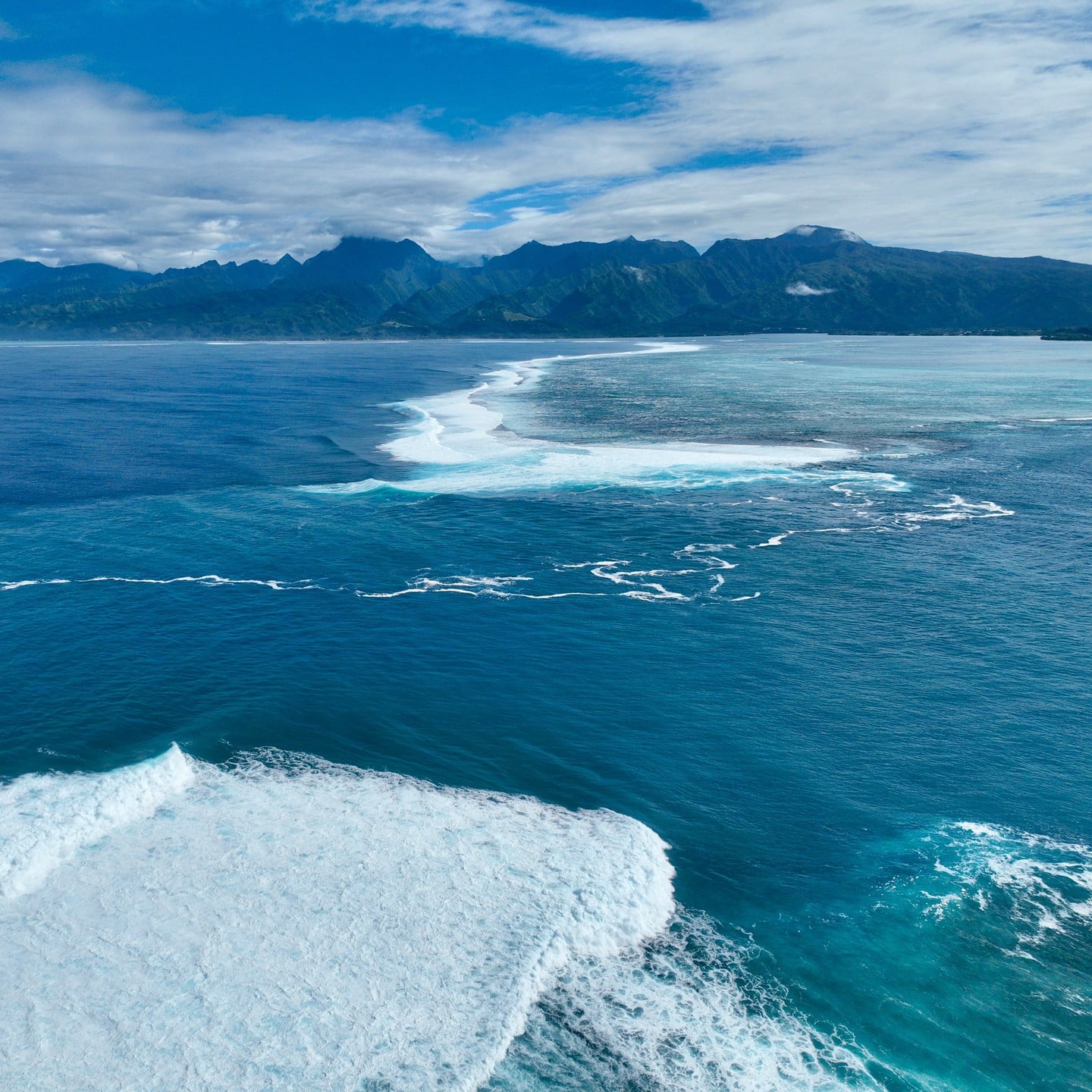
Bénédicte and her family chose to visit the Gambier archipelago: “In Polynesia, to get off the beaten track, we chose to head for the Gambier archipelago. Getting there from Panama is demanding: nearly 3 weeks at sea, at less downwind than usual, on a beam. But with a 55-foot catamaran like ours, that’s no problem. The Gambier archipelago alone is a concentration of the best of the Marquesas, the Tuamotus and the Leeward Islands. As in the Tuamotus, there are motus and a magnificent coral reef with a rich underwater fauna. We had a wonderful time, both underwater and on land! There’s a very strong culture here, with very warm values of sharing and hospitality. It’s easy to make contact, especially when it comes to bartering for the fruit and vegetables that grow in the inhabitants’ gardens, just like in the Marquesas Islands. As in the Leeward Islands, you can enjoy lovely walks and hikes in the forest, along well-kept gardens, with magnificent views from the summits. You can also visit pearl farms producing some of the finest pearls in the Pacific.”
Many yachtsmen are won over by French Polynesia. Arriving at the furthest point on the globe from France, they often feel they have found the most beautiful place on earth and sometimes decide to call it a day. However, further down the road, there are so many other wonderful destinations to explore on a catamaran!
As you continue westwards, still in the South Pacific, you’ll discover other countries and peoples that are well worth a stop. In the Cook Islands, the Samoan archipelago, Tonga and Wallis and Futuna, your sails will take you to magical places, where you’ll come into contact with people who are, once again, very welcoming. In Fiji, you’ll enjoy traditional villages and numerous spots perfect for water sports. The stopover in Vanuatu should also provide you with some unique experiences…

On the subject of New Zealand, Bénédicte confides: “Everyone thinks that it can only be visited by van, but it’s a well-kept secret that it can also be visited by sail! It offers three exceptional sailing basins, each with dozens of safe anchorages, splendid panoramas, magnificent walks and easy access to supplies. Not to mention the restaurants and vineyards!”
Finally, New Caledonia and Australia are also good stopping-off points before leaving the Pacific: as well as a change of scenery, you’ll find everything you need to maintain and refuel your catamaran before continuing your journey.
From the Torres Strait to the western Indian Ocean
While some yachts opt to sail around Australia, most take the Coral Sea and Torres Strait to reach the Indian Ocean. Explore Papua and the Raja Ampat archipelago, East Timor and the Komodo dragons, Borneo and the orang-utans, or enjoy cultural adventures and idleness in the world’s largest archipelago: Indonesia!
Some crews choose to sail all the way back to Thailand, sometimes leaving their boat in the town of Krabi for a while.
One of the little-known destinations on our westward journey is the small Australian archipelago of the Cocos (Keeling) Islands: a stopover in the Indian Ocean that Bénédicte describes as “very interesting from every point of view” . She remembers an excellent anchorage, a magnificent stretch of water for wingfoiling, a pleasant and friendly beach, and some great snorkelling sessions. On the neighbouring islet, which is inhabited, there are also plenty of opportunities for cultural visits! After that, the journey continues, sailing across the Indian Ocean to Mauritius, the Maldives, the Seychelles or Reunion Island. For Bénédicte, Mauritius should be much more than just a stopover: “It’s the traditional stopover on a crossing of the Indian Ocean, where the boats think about stopping off, content to stay in Port Louis. It’s true that it’s a nice stopover, with the Caudan marina, its large open shopping arcade, its museums, its lively market, its restaurants… But Mauritius can also be visited by sail! On two occasions, with both Saga and Moby, we sailed around Mauritius, stopping at various anchorages: on the east coast, at Trou d’Eau Douce – which gives access to Ile aux Cerfs, Mangénie islet, Mahébourg – an old colonial town – and Blue Bay marine park; on the west coast, at Rivière Noire – which gives access to Gorges park – and Tamarin, with its surf beach and magnificent sunsets. Finally, to the north, Grand Baie and the surrounding area offer lively, beautiful beaches and several other pleasant little anchorages.”
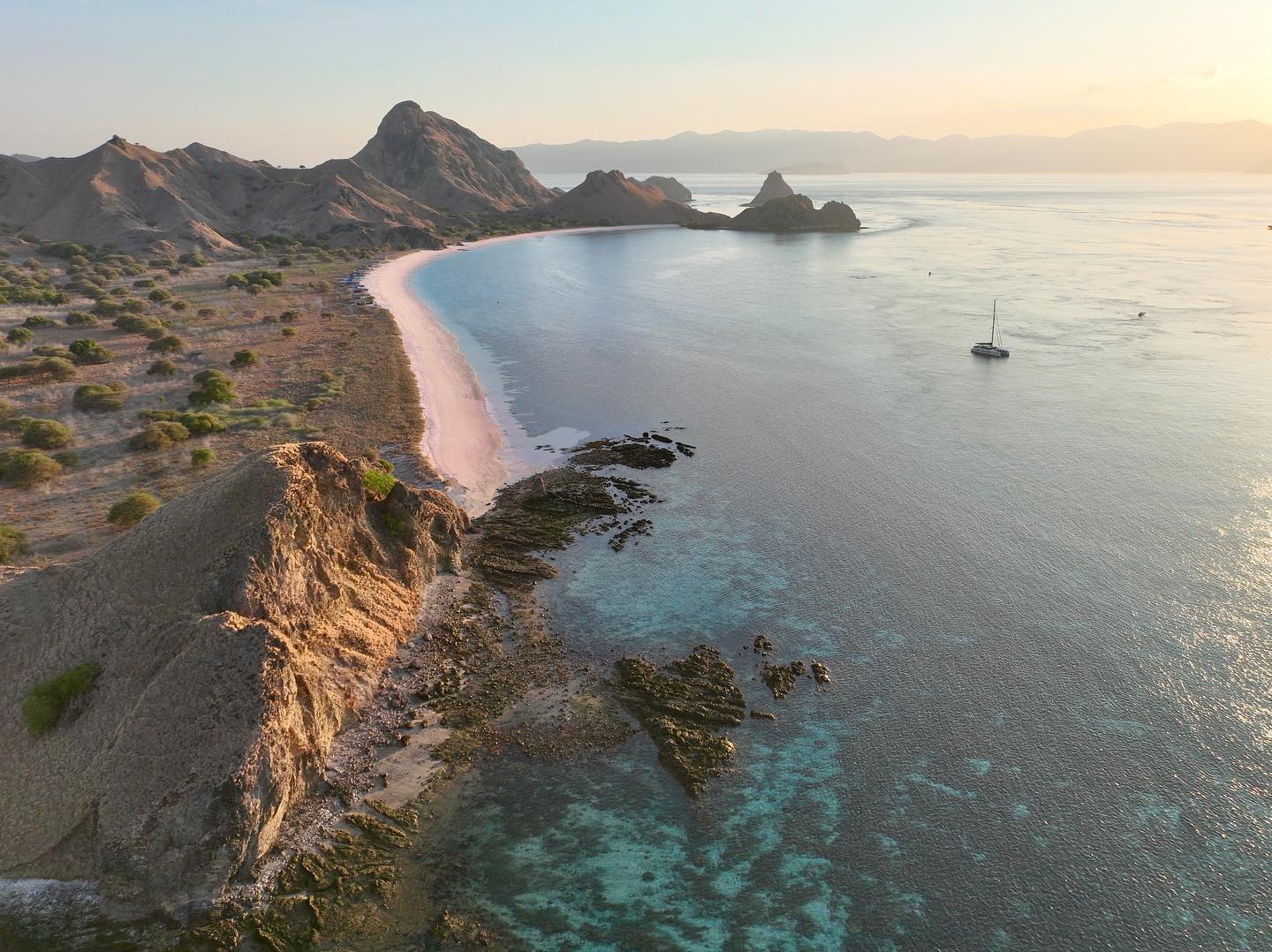
As well as this well-known destination, the yachtswoman recommends visiting other territories in the Indian Ocean: “The Chagos Islands, for example, are a nature reserve teeming with birds and fish! There are thousands of coconut crabs, frigate birds, dolphins and dolphinfish in the inner lagoon, as well as a wealth of underwater life. You can spend a maximum of three weeks here, with permission. And it’s a privilege to witness such a wild and abundant nature”. The deserted archipelago of Saint-Brandon is also well worth a visit: “It’s a well-known destination for yachtsmen from Mauritius and Reunion, where you’re guaranteed a change of scenery! It’s a semi-enclosed atoll made up of dozens of islets of varying sizes, renowned for its seabed and fishing. When it comes to board sports, it’s paradise: there are exceptional kitesurfing and wingfoil spots, wild beaches with rare shrubs and thousands of birds.”
n the end, Rodrigues is a small island with an old-fashioned, tranquil atmosphere, which the traveller still recommends: “We spent ten fantastic days sailing there. The island is very welcoming and offers two anchorages: in town, at Port Mathurin, and at Port Sud-Est. The first offers a very pleasant stopover with a market and small restaurants. The second is a spectacular anchorage on the inner edges of the channel, with direct access to the lagoon and ideal spots for wingfoil and kitesurfing.”
Bénédicte insists that, for her, the Indian Ocean’s great cruising destinations are poorly known and largely underestimated. For her, the Indian Ocean is an “exceptional sailing destination on a catamaran”.
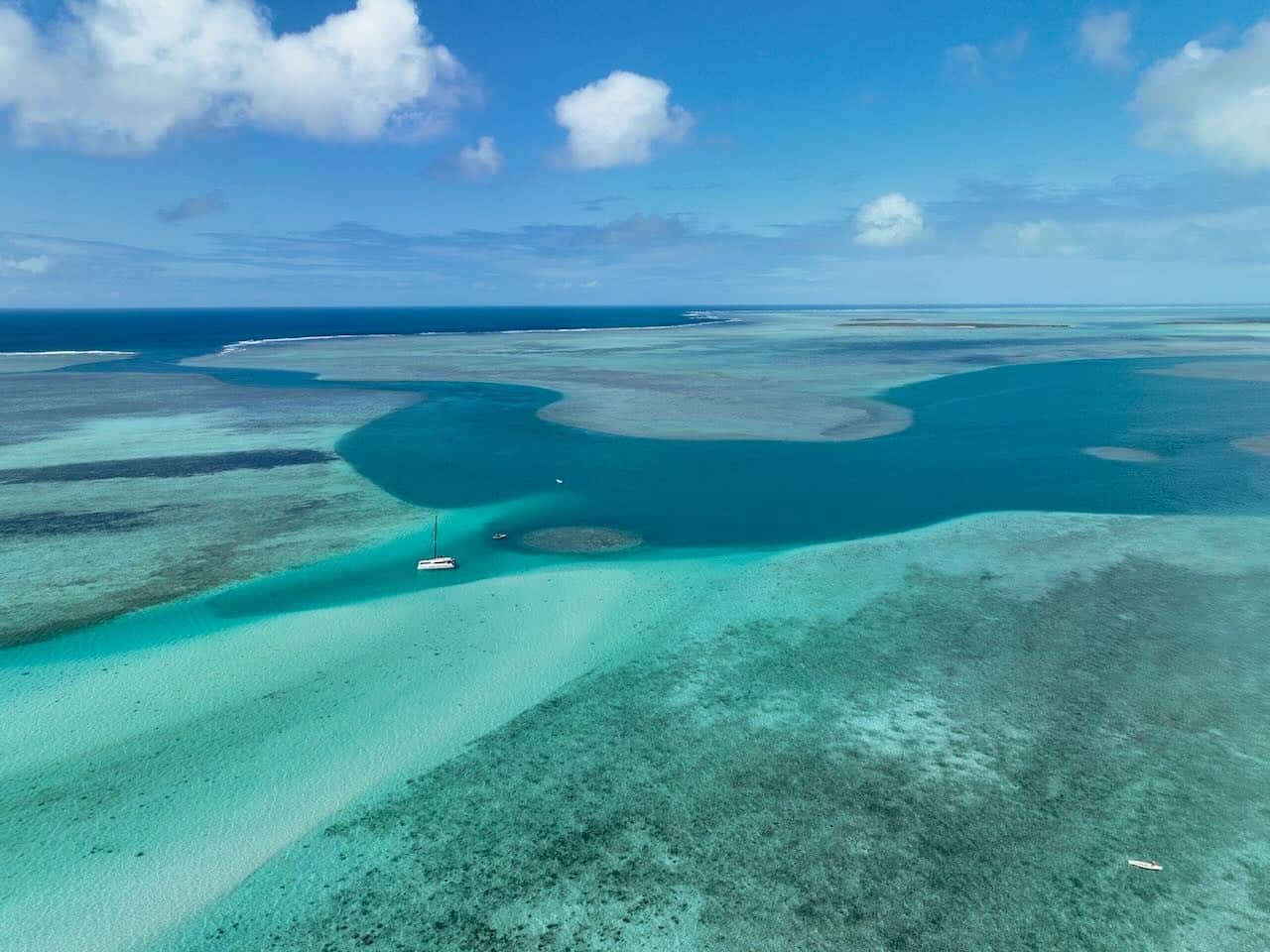
After visiting these destinations, it’s already time for your final stopovers in the Indian Ocean. Depending on the stopover points you have chosen and whether or not you wish to use the Mozambique Channel, you will make a stopover in Madagascar or Tanzania, or head straight for South Africa.
This country will be a compulsory stopover – but also a very pleasant one! – before your second Atlantic crossing: the stopover in Cape Town will allow you to prepare the boat for one of the last ocean crossings, in a port where everything is easily accessible. Here, you can wait comfortably for the right “weather window” to cross…
Sailing back to Europe from South Africa
You will cross the South Atlantic Ocean from east to west. On this occasion, you may make a stop on the territory of Saint Helena. But where to next?
In the Western Atlantic, before returning to Europe, you may be tempted to make the same stops as on your first passage. But if you want to see more, your round-the-world catamaran trip could be the perfect opportunity to visit some new destinations! Brazil, the Bahamas, Bermuda and the United States, for example, are still waiting for you.
Finally, for your last ocean crossing, the return Atlantic crossing, you will undoubtedly stop off in the Portuguese archipelago of the Azores. There’s no doubt you’ll meet other crews who, like you, have sailed around the world in a catamaran. It’s the perfect opportunity for us to look back together at all these beautiful stages…
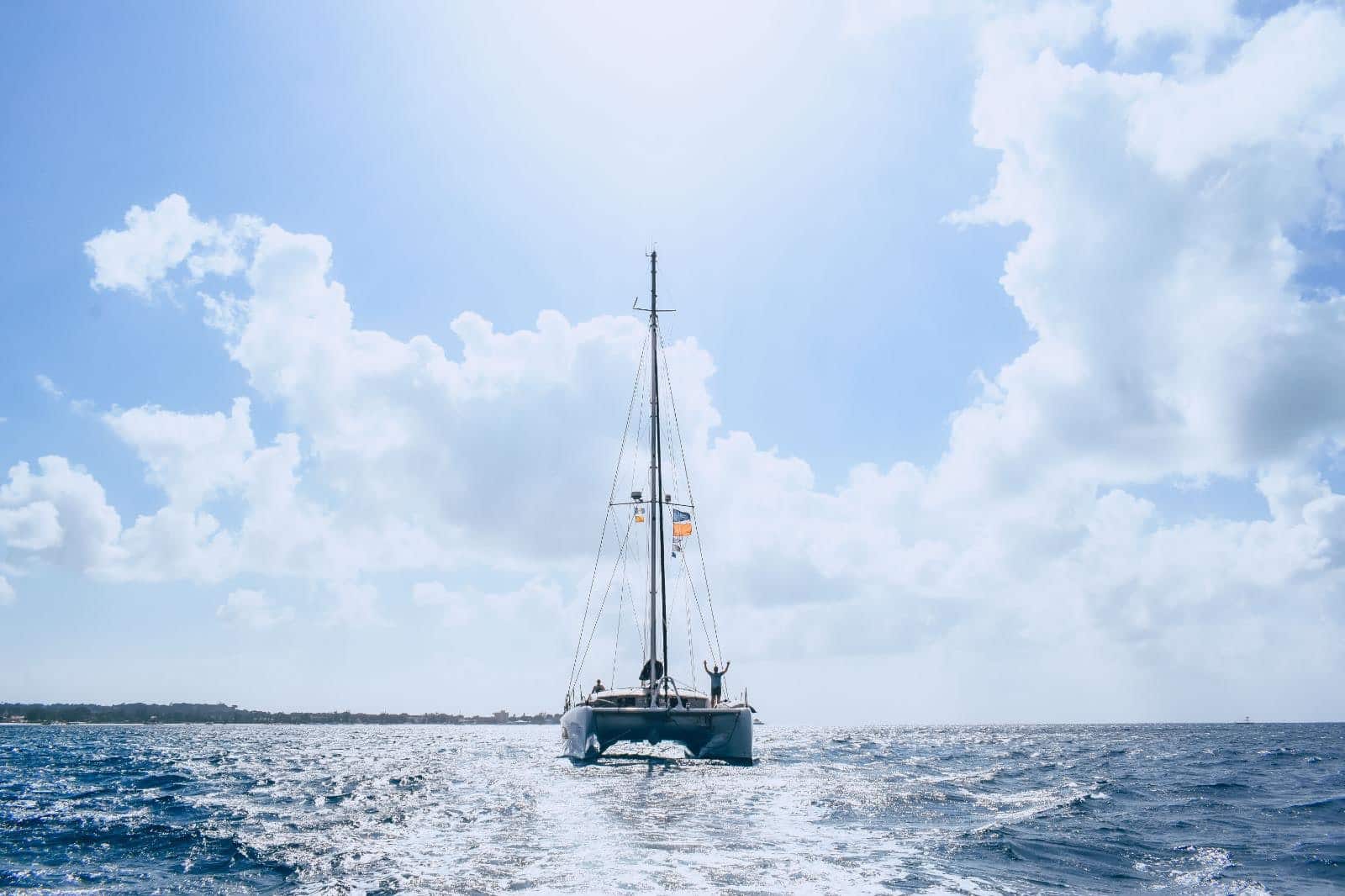
Gone are the days of the great explorations. You probably won’t have the chance to discover unexplored lands by sailing around the world on a catamaran these days. On the other hand, by choosing stopovers off the beaten track, you’re sure to feel like an adventurer! Just what you need to make your round-the-world sailing experience unforgettable…
Read also: Working remotely and sailing around the world: David and Inês are living the dream onboard their Outremer 5X
Continue navigation
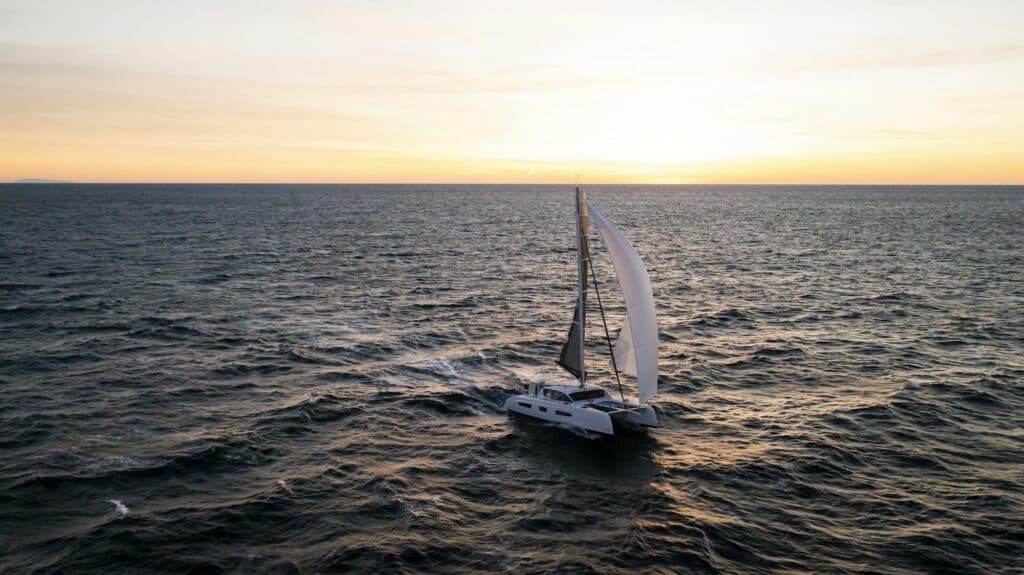
Why sail around the world in a catamaran rather than a monohull?
Sailing around the world is a dream come true: you discover the world to the rhythm of the wind and the stopovers, exploring new destinations every day as you sail. If you’re just starting to read this article, you’re probably nurturing this project. Are you planning to sail around the globe? Then the choice of ship for your next voyage is crucial.

The Importance of Defining Success
In the Autumn of 2023, I ran a ‘Webinars for Women’ mini-series on transatlantic preparations. The first session was titled: “How to approach transatlantic preparation.” As I zoomed out of the nitty gritty of canned food recipes, spare parts inventories, and preventative sail repair and took a broader look at the framework for a successful crossing, I homed in on what I think the first and most important step is: defining your goal.

Sailing in the Bahamas : unforgettable stopovers
The Bahamas Islands are a dream destination to explore under sail! In the heart of the Caribbean Sea, the archipelago offers the chance to enjoy sailing through splendid scenery, pleasant places to stop off and memorable activities. In this article, the Outremer team tells you what they consider to be the essential stages of a catamaran cruise in the Bahamas.

My Cruiser Life Magazine
Best Catamaran for Sailing Around the World — Best Cruising Catamarans
Sailing around the world is a dream of many. It’s the grandest adventure you can have in a sailing vessel—or at least one of the top five. But what kind of boat do you choose?
For many, the go-to answer has become a bluewater catamaran. These boats offer outstanding comfort and living space. They outperform most monohull sailboats of their size, and their bright and airy salons and cockpits will convert non-sailors to the ideas of what is possible with such a boat.
Here’s a look at some of the best long distance cruising catamarans and why these boats are great choices for many crews.
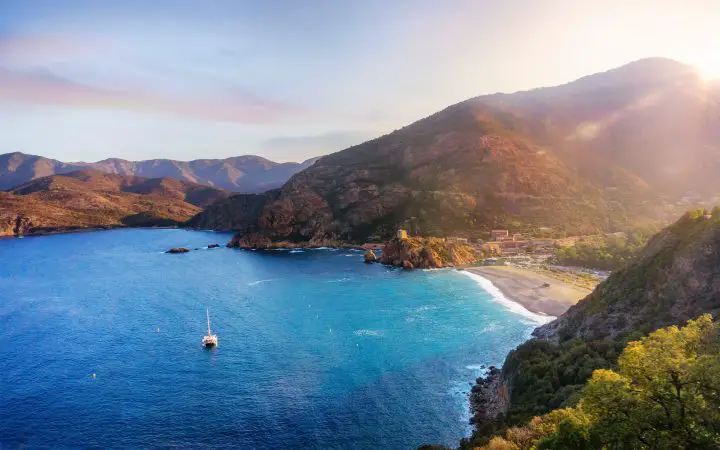
Table of Contents
Lagoon 440/450/46, leopard catamarans 42/43 (circa 2000-2007), pdq antares 44/44i, catana 471/47, fountaine pajot orana / helia 44, balance 482, what is a cruising catamaran, cruising catamaran pros, cons of catamaran offshore cruising, what to look for — best catamaran for sailing around the world, best cruising catamarans faqs, 8 popular choices for best cruising catamarans.
Every boat has strengths and weaknesses, and every list is biased. There are tons of boats out there, and it’s impossible to be familiar with every single one. Furthermore, as time passes and our needs change, the types of boats that catch our attention change.
Sailing long distances, like around the world, is a very specific mission. It’s not something you wake up one morning and say, “Today, I’m setting off around the world!”
No, a circumnavigation is the culmination of years of preparation and research. Just finding the right boat is a big part of that. Some experienced cruisers make their business helping people find the right boat to suit their needs. If you’re completely lost in the boat-buying process, reaching out to an experienced expert (not just a yacht broker!) is an important step.
One such person is John Neal. Neal runs Mahina Offshore Services and is a consultant for folks wanting to cast off the lines. He’s written extensively about what makes a good bluewater cruiser and specializes in boat consultations. Be sure to visit his website and download his free ebook, Selecting and Purchasing an Ocean Cruising Sailboat.
Another great resource, especially if you’re considering voyaging with your kids, are Jamie and Behan Gifford of Sailing Totem . They work as consultants helping couples and families find their path to a successful circumnavigation—what they call “from dream worthy to seaworthy.” Totem and crew crossed their wake a few years back, and they write for Cruising World and often speak at events like Cruiser University at the Annapolis Sailboat Show in the fall.
Here’s a look at some of the most popular long-distance cruising catamarans. This isn’t an all-inclusive list, nor are these really recommendations. Rather, they’re a look at some boats, both good and bad, to consider for the ultimate sailing adventure.
View this post on Instagram A post shared by Katamarans (@katamarans)
Lagoons are the ubiquitous production boat of the catamaran world. Next to Leopard, they dominate nearly every list of catamarans since the company makes so many of them. They’ve been cranking these boats out for over 20 years, longer than many other manufacturers. When you do the math, there’re more examples of individual Lagoon models out there than hulls made by many other manufacturers combined.
What does all that mean for the buyer? For one thing, it means it’s not hard to find a Lagoon for sale. If you pick your model, you’ll probably find a few dozen for sale worldwide at any given time. A cursory look at Yacht World shows 23 listings for the 440 and another 77 for the 450 (not including those listed separately as 450F and 450S!).
The 440 was the first of Lagoon’s popular flybridge models. This offers an upper level so that the helmsperson can see all points of the boat and is separate from the salon and cockpit area. Many liveaboard 440 owners have converted the upper flybridge with an enclosure to make it an all-weather helm.
The 450 took the 440’s success and improved all the details. The updated design was one of the most popular boats Lagoon ever made. They eventually divided the lineup it the 450F, with the standard flybridge, and the 450S, with a “sporty” helm on the aft coachroof.
Both are very popular boats and are sized right for world voyaging. They aren’t without problems, however. Around 2020, many owners began discovering serious problems with bulkheads delaminating from the hulls. However, Lagoon has an official fix, and many boats have been successfully repaired. As always, get a good survey, research, and ask the right questions!
Lagoon 450s are currently listed for anywhere between $400,000 and $800,000. 440s are older and can be found between $275,000 and $450,000. As always, keep your eyes peeled for the less common and much more comfortable owners’ version layouts with one huge master cabin.
View this post on Instagram A post shared by Solo Deniz (@solo_deniz)
Leopard is another ubiquitous brand in the catamaran world. The company’s newer models, like the current (2023) Leopard 45, have a forward seating area and a large opening door on the front of the salon. In short, they’re perfect charter boats. Leopard habitually reuses their model numbers repeatedly, making getting the right model confusing. The newest Leopard 42 started production in 2020 and features the forward patio lounge.
The Leopards included on this list are much older and lack this forward patio design. Instead, these original Leopards have a low-profile aesthetic perfect for ocean sailing. They’re comfortable and functional. They’re a little on the small size for world cruising but would be perfectly suited for a couple that wants the smallest boat they can get.
The difference between the two models was only one thing—the 42 included a soft-top bimini, while the 43 had a hard top. Most owners have now converted their 42’s soft top to a hard one.
Leopard 42s and 43s from 2000 to 2007 are currently listed between $250,000 and $350,000. The 43s, which are a bit newer, go for just a little more. Since so many saw charter use, finding good examples with owner’s layouts is hard. When you do, they’re worth the trouble to bring home.
If you’re looking for a bargain, the older Leopard 45 and 47 were remarkably similar in design. They are less common on the used market today, but if you find one in good shape, it’s worth a look.
This boat started life built by Canadian catamaran builder PDQ. The design was wildly successful. However, when PDQ shut down, the hull molds made their way to Argentina and found new life. This is one of the few catamarans out there that is built for the specific mission we’re addressing here—a long distance cruising catamaran for a couple or a small family.
The Antares is built from the keels up to be reliable, simple, comfortable, and safe. She’s not winning any races against the Outremers, Gunboats, or fastest catamarans of the world, but she makes up for it with her sturdy design and comfortable handling.
At 44 feet long, she’s the perfect length for a voyaging catamaran. She has impressive bridgedeck clearance and can handle most anything King Neptune throws her way. Her fit and finish are above average—excellent, in fact—and her layout is supremely functional. This is one catamaran that must be on your shortlist if you’re considering a circumnavigation.
Currently, two Antares are listed on the market, from $595,000 to $798,000. Only a handful of 44s are out there, and while the boat has been in production since around the year 2000, there just aren’t many to choose from. Those that are out there are coveted for their build quality and seaworthiness, so they don’t come cheap.
Catana is a French builder that makes performance catamarans with retractable daggerboards. These improve upwind performance dramatically and reduce your draft when gunkholing. Proponents of daggerboard designs will also point to their improved handling at sea, allowing the boat to slip freely down waves, thereby reducing the likelihood of capsizing in extreme conditions.
Catanas also feature a unique helm layout. Twin helms are located outboard on each stern, so you can pick your driving position for the best visibility, the best shade, or the best breeze. You’ll be driving with the autopilot from the nav station at sea anyway. It keeps sailing a little more fun when you’re out there for the fun of it.
The 47 and 47OC (Ocean Class) are the newer versions of the boat. All versions feature Catana’s uniquely strong, lightweight composite layups and distinctive asymmetric narrow hulls. They’ve got outstanding bridgedeck clearance and
Catana 47s and 47OCs are listed between $360,000 and $700,000. The older 471 is a little harder to find. Catana has always been a higher-end, low-volume brand that makes fewer hulls each year than other makes.
Fountaine Pajot is the third of the “big three” catamaran makers. The French brand is often compared to Lagoon and Leopard, but their designs have always stuck more on the performance side than the bulky cruiser side. In the ocean-going length, their 44-footers are just about right.
Regarding layouts and features, it’s hard to imagine a more perfectly suited boat than the FP 44s. These boats are big enough to carry all your stuff and give you space to spread out. But they’re also good sailors and stable at sea. They feature the preferred coachroof-mounted helm, which is raised enough to provide good visibility without being disconnected from the action in the cockpit.
Oranas are currently listed from $295,000 to $468,000, while the newer and more popular Helias go for anywhere from $447,000 to $649,000. These were popular boats with private owners, and in charter, so there are usually quite a few available.
View this post on Instagram A post shared by David & Amy (@outchasingstars)
Mantas are a well-built, American-made catamaran sailboat that went through several revisions. Overall, the hulls and layouts never changed from the early 38s to the last 42 Mark IVs. But the transoms were extended for speed and better handling, and the extra length of the later models makes them just right for a small ocean-going cat.
Balance is a South African company that has made their business to produce a modern sailing catamaran for a new age of sailing. This isn’t a legacy brand, so you aren’t going to find one at a bargain price. Instead, these boats are being built on a semi-custom basis for owners like us who want to sail their boats around the world.
The company describes the Balance 482 as a “trend-setting circumnavigator.” It won Boat of the Year from Sailing World Magazine in 2022.
HH boats are built in Asia as cutting-edge sailing catamarans for the owner/sailor market. They’re designed by Morrelli and Melvin, one of the multihull world’s top design firms.
These boats are also semi-custom, so you won’t find many on the used market. They’re known for their modern innovations, including a fold-down swim platform and an EcoDrive hybrid system. You can spec your boat with either mini keels (OC or “ocean cruising”) or daggerboards (SC or “sport cruising”).
The HH50 is the company’s best bet for circumnavigating with a small family. There’s also the capable, smaller sistership, the HH44.
Why Are Catamarans Great for Long-Distance Voyaging?
Catamarans are immensely popular for a few reasons. For one thing, they’re some of the most comfortable boats for long-term living aboard. They offer lots of living space, storage, and tankage. They have panoramic views, with huge windows letting light and air into the open salon. Unlike classic monohull sailboats, they are not dark and stuffy at all.
Catamarans also don’t heel like monohull sailboats do. This is good and bad, but most people (especially non-sailors) prefer it. It means when you’re sailing, you aren’t at an angle for days or weeks at a time. Your stuff isn’t constantly rolling downhill on the counter and falling out of the medicine cabinet whenever you open the door. They still move and rock on the waves, but the motion is always more upright than heeled to one side.
There are a dozen other reasons folks prefer catamarans to monohulls for long-distance or long-term traveling. And, like all things in boating, every sailor is a little different. Some don’t like catamarans and prefer a beefy bluewater monohull’s stability and solid feel. Your mileage may vary, as the saying goes.
Of course, the longest voyage of them all is sailing around the world. The typical downwind circumnavigation involves several long-distance passages and many months of hopping through remote island nations. The longest leg is typically from Panama or the Galapagos Islands to French Polynesia (The Marquesa Islands), a leg of at least 3,000 nm that typically takes 20 days or more.
In total, a circumnavigation takes at least 18 months but commonly even longer. That’s a long time to spend on any vessel, so the comfort of a cruising catamaran makes a lot of sense.
A cruising catamaran is roughly defined as one designed to carry passengers and crew long distances. Obviously, this means it needs to be equipped with staterooms and heads, a galley, and a salon. But that also means it must hold enough fuel and water to keep its passengers safe for long voyages.
The cat also needs to be designed to be stable enough for all of that to be used to capacity. Two to four people, plus enough supplies to keep them fed and healthy for months, weighs quite a lot. Then you add in spare parts, water toys, and other goodies, and it adds up. Catamaran speed and stability come from its lightweight design. If you make it too heavy and overload it, it will be slow and less stable in rough conditions.
When you consider all of this, you’ll come up with a minimum size for a catamaran to carry all the stuff you need for such a long voyage. Generally, the smallest cats in this class will be around 42 feet long. This is the right size for a cruising couple that doesn’t often sail with others. A 44-footer will be a little more comfortable and make having occasional guests onboard a more pleasant experience. Once you get to 50 feet or longer, the boat is a bit large for most private owner skippers to handle. Costs start to balloon at this length and above, as well.
What about a small catamaran ? Many people have successfully done the trip in smaller boats, of course. Generally, however, these smaller cats are pushed to their limits in terms of load carrying capacity. In most cases, circumnavigators will take on extra crew for longer legs (this is sometimes even an insurance requirement!). The ride in rough seas is not as good in shorter cats, which tend to hobby horse more in a chop. So, overall, 42 feet and above is about the sweet spot.
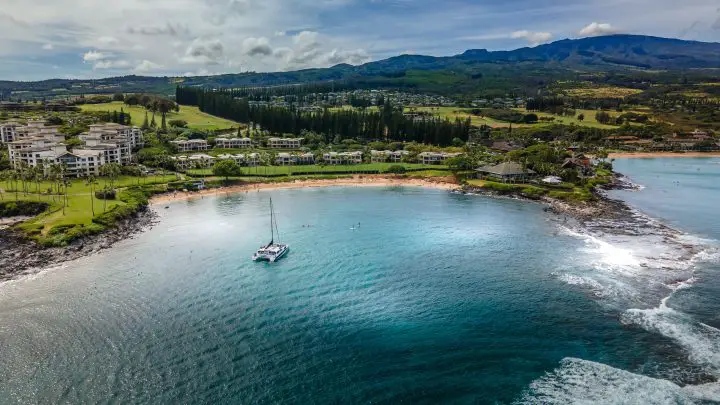
Comfortable Living Space
The huge salons and cockpits catamarans offer, with comfortable seating at big tables, truly improve your life at sea. The importance of all the light and air coming through those windows can’t be underestimated—it’s great at anchor when enjoying the sunset. But it’s also great to have an interior nav station where you can keep watch from the comfort of the salon. In short, a liveaboard catamaran is one of the most comfortable options for any type of cruising.
Better Speed, Especially Downwind
Compared to monohulls of similar length, catamarans are nearly always faster. This goes for fast catamarans, sure, but also for cruising catamarans. This becomes very apparent when traveling downwind, something that most monohulls struggle with. And downwind is the preferred direction to travel on a sail around the world route .
Comfort at Sea
The lack of heeling makes catamarans the preferred choice for long distance sailing. When given the choice of doing a 20-day passage perfectly upright or at a 10-degree tilt, which would you pick? Even the saltiest of sailors has to agree that heeling over is fun for a while but gets tiring quickly.
Redundant Systems and Structures
With two hulls, two engines, two water tanks, two fuel tanks, two sets of bilge pumps, and tons of other redundancy built in, catamarans offer owners extra layers of safety.
If all of this sounds too good to be true, it’s because we haven’t discussed the most limiting factor for most sailors—the cost of the boat! Catamarans are expensive from the outset. When juggling all of the factors with an around-the-world cruise, boat cost is the biggest.
Catamarans cost more than monohulls for many reasons. They are larger, but even still, they often sell for more. One reason is their popularity. These boats are in demand. Far fewer examples are on the market than monohulls, and more buyers are looking to purchase them. So prices are high and are likely to stay high. On the other hand, Monohull prices are much lower because there are more monohulls out there than there are monohull buyers.
With any boat, there is also the cost of keeping it once you own it. The larger the boat, the greater your expenses will be. This is true for everything from maintenance to storage. Catamarans cost more than monohulls in nearly every instance. For maintenance, you’ll be limited to facilities that can haul a boat with your width—which will be more expensive. You’ll have two engines, which means twice the maintenance and twice the replacement cost when that time comes.
Choppy Motion
Despite all the plusses and the flat ride, plenty of sailors out there just don’t like the ride a catamaran offers. You have to take one to sea to understand fully. A catamaran is light and tries to fly across the water, from wave to wave. It smacks each wave twice and always tries to come back upright after each impact. This leads to a choppy, jarring ride sometimes.
A monohull is built heavy and is designed to slice through the waves and push the water out of its way. The wind pressure on the sails keeps the boat’s angle steady (in most cases). So, a heavy monohull can ride quite comfortably in a chop, whereas a catamaran might feel like it’s taking a pounding. Many heavy-displacement monohulls built for long-distance travel were designed to provide a soft, comfortable ride that allows the crew to rest.
All sea conditions are different, as are all sailors and their expectations. So this is a personal choice as to which method you like better. And for every condition uncomfortable in a catamaran but smoother in a monohull, there’s something smooth and lovely in the cat and uncomfortable in the monohull. The ocean is just like that.
All cruising cats over about 40 feet are capable, and most have become proven circumnavigators in the past few decades. The right one for you simply comes down to the balance of cruising amenities versus performance. Fast catamarans are all the rage, but you’ll have to put a price on exactly how much performance you can afford.
To learn more about other boats before deciding, check out:
- Catamaran vs Pontoon
- Yacht vs Sailboat
What type of boat is best for sailing around the world?
The type of boat best suited to sailing around the world is a well-built, long-distance cruising boat. Many sailboats fall into the camp, both monohulls and catamarans.
This question has a million answers. Ask every sailor who wants to go around the world, and you’ll get a different one. And, once they’ve sailed around the world on that boat, they’d choose a different boat. The only rule is that there is no perfect boat.
What is the best catamaran to sail Caribbean?
Catamarans are extremely popular in the Caribbean because their open-air living space allows cooling airflow. Their living space is supremely suited for the tropical environment—imagine living al fresco on the waterfront all the time!
The right catamaran for the job depends on your group size and how long you intend to spend aboard. Full-time liveaboard couples prefer cats in the 38 to 44-foot range, while small families opt for something slightly larger.
Are catamarans easier to sail?
Catamarans are easy to sail—but similar to sailing a similar-length monohull sailboat. Beginners sometimes find them less intimidating because they do not heel and therefore seem more stable. However, monohulls are more forgiving of errors. Catamarans have large sails and rigging, and reefing early to avoid overloading the rig is extremely important on these boats. For more on beginner boats, check out my post: Best Boat for Beginners .
Matt has been boating around Florida for over 25 years in everything from small powerboats to large cruising catamarans. He currently lives aboard a 38-foot Cabo Rico sailboat with his wife Lucy and adventure dog Chelsea. Together, they cruise between winters in The Bahamas and summers in the Chesapeake Bay.
Leave a comment
Your email address will not be published. Required fields are marked *
Save my name, email, and website in this browser for the next time I comment.
- THE PRINCESS PASSPORT
- Email Newsletter
- Yacht Walkthroughs
- Destinations
- Electronics
- Best Marine Electronics & Technology
- Boating Safety

The Power Catamaran Compilation
- By Yachting Staff
- Updated: December 21, 2018
Power Catamarans have been growing leaps and bounds in popularity, and, in lengths and widths. And for good reason. These cruise-centric yachts offer homelike livability for avid travelers, are fuel efficient and are fairly intuitive to run. Power cats are popular in the bareboat charter market too, for these very reasons.
Here, we take a look at 12 catamarans ranging from a cruising-couple-size 36-footer to a 78-footer for friends, family and some more friends. And there are myriad power options: outboards, diesel inboards, hybrid or even all-solar power.
Fountaine Pajot MY44
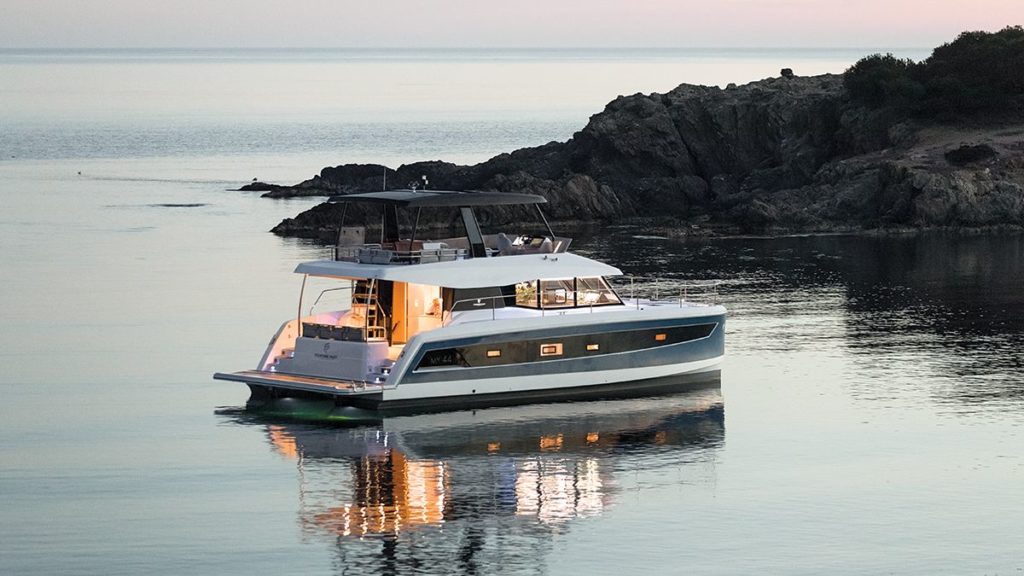
The Fountaine Pajot MY44 , a creation of Italian architect Pierangelo Andreani and French designer Daniel Andrieu, has a main deck that’s open from the aft-deck seating all the way forward to the starboard helm station. The sense of spaciousness is significant, for several reasons. First, four glass panels aft can all slide to port, creating an indoor-outdoor space with the aft deck and salon. In the salon, 32-inch-high windows extend for 12 feet down the sides of the yacht, with three sections per side, bringing in natural light along with the three forward panes that comprise the windshield. Finally, 6-foot-6-inch headroom provides vertical clearance, with a 21-foot-7-inch beam that adds interior roominess while keeping the yacht stable.
Read more: Fountaine Pajot MY44
Silent-Yachts 55
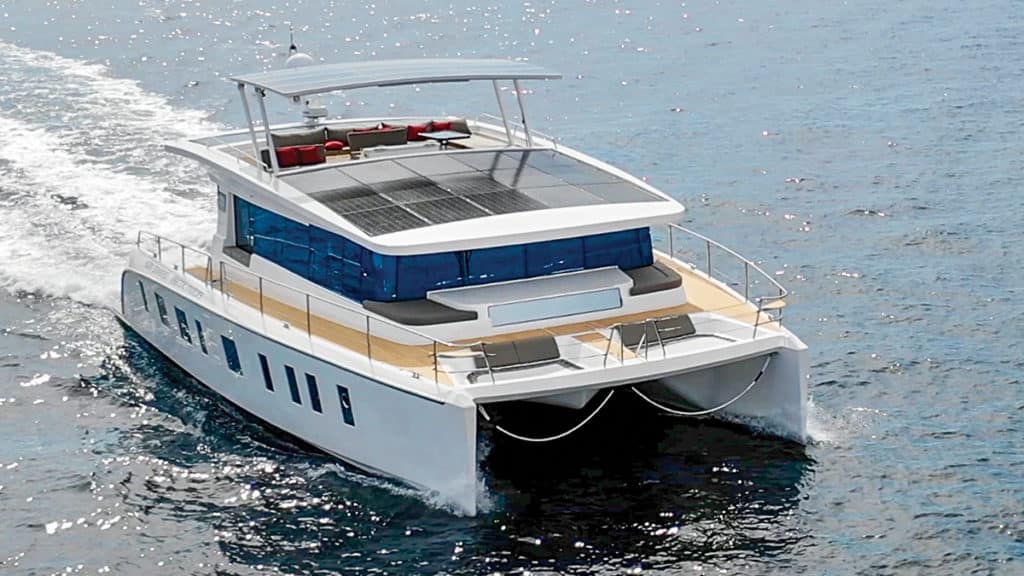
The ideas about which solar panels, electric motors, inverters and the like to use — and more importantly, Michael Köhler says, how to configure them — became the basis for the brand Silent-Yachts. The company offers 55-, 64- and 79-foot catamarans that run on solar-electric propulsion. The Silent 55 premiered this fall, and the 64 is sold out for the next two years, Köhler says.
Read more: Silent 55
Horizon PC74
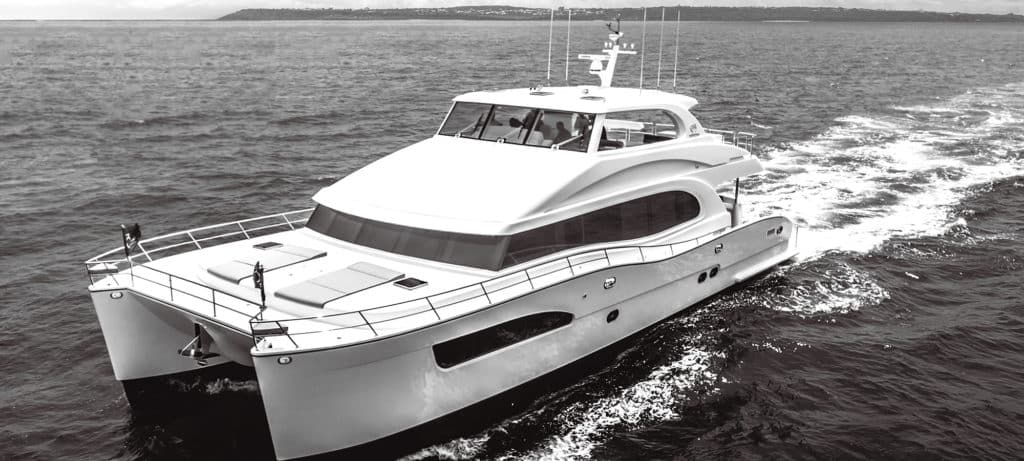
As founder and director of The Powercat Company, a Horizon Power Catamarans distributor, Stuart Hegerstrom had long believed that catamaran builders needed to design their yachts to more stylish standards.
“The boats were very boxy,” he says, based on his years of experience with cats in the charter market. He and his partner, Richard Ford, asked Horizon to produce models that had high-end finishes and looked good inside and out.
The Horizon team brought in mega-yacht designer JC Espinosa to work with its own craftsmen. The result aboard the Horizon PC74 is a catamaran with exterior styling, layout and functionality that should appeal to private and charter owners alike.
Read more: Horizon PC74
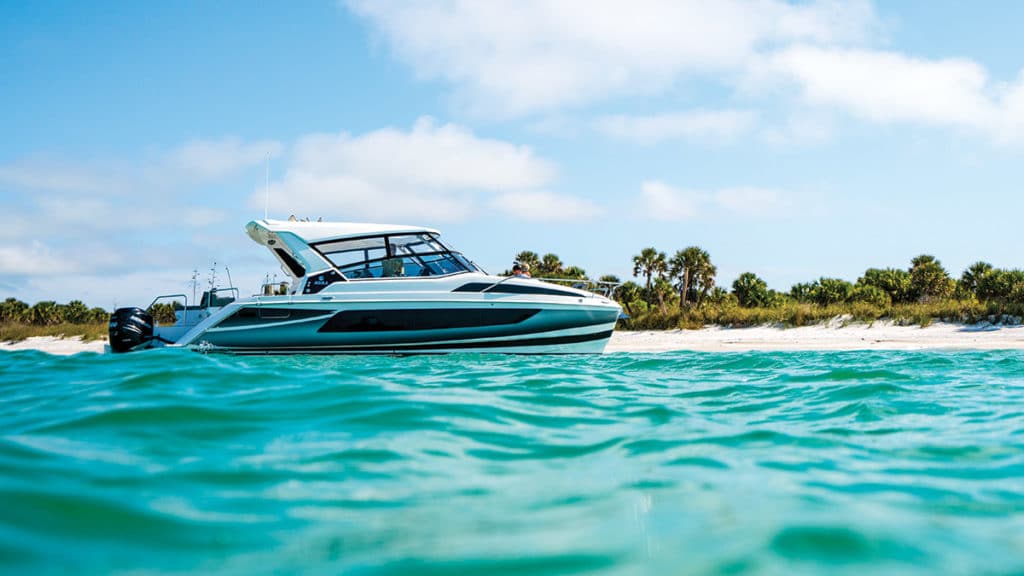
The Aquila 36 is a departure from her sisterships in that she is an outboard-powered, express-cruiser-style catamaran, but she also adheres to MarineMax’s philosophies.
With a single main living level from bow to stern and a beam of 14 feet 7 inches, the Aquila 36 is like a bowrider on steroids. She has seating that can handle 20 adults for outings and barbecues, and there are two staterooms below, one in each hull, for family weekending. The staterooms have nearly queen-size berths, en suite heads, stowage and 6-foot-6-inch headroom.
Read more: Aquila 36
Lagoon Seventy 8 Powercat
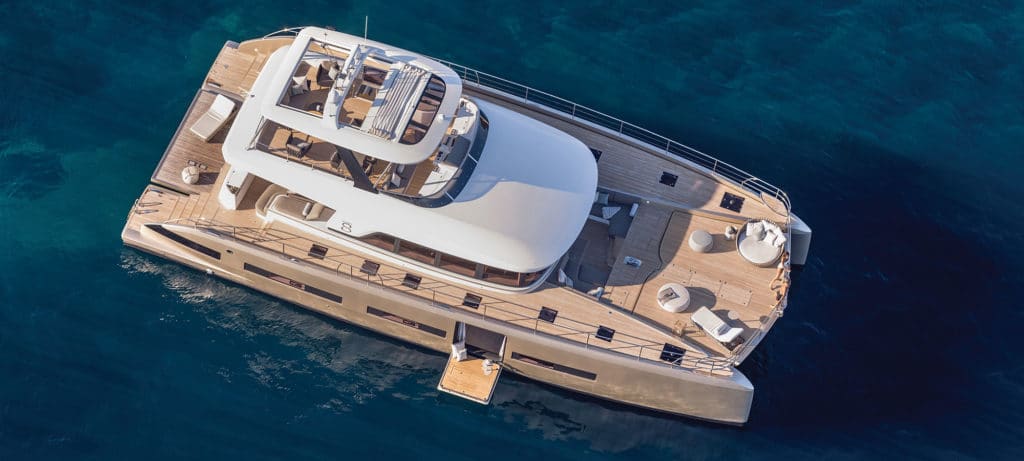
Lagoon is a division of Groupe Beneteau, the world’s largest builder of sailing yachts, and the Lagoon Seventy 8 Powercat is a developmental sistership of its Seventy 7 super sailing cat. The Seventy series yachts are built at Construction Navale Bordeaux in France, which had to add a new yard to construct these catamarans because they require separate stern molds for the power and sail versions.
Read more: Lagoon Seventy 8 Powercat

Horizon PC60
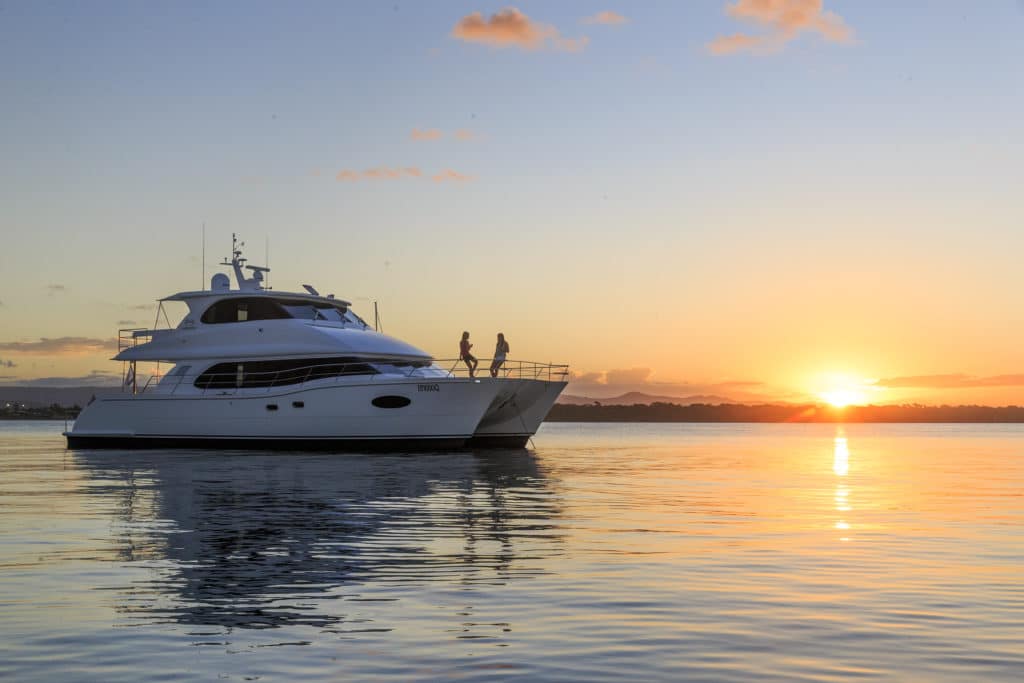
To understand the Horizon PC60 power catamaran , you need to put aside preconceived notions about midsize yacht amenities. For example, main-deck master suites are the province of yachts over 100 feet length overall. Incorrect. This 60-footer has an elegant and spacious owner’s stateroom on the same level as the salon. If you want a 14-foot center console tender on a 60-foot yacht, you have to tow it. Wrong again. On the PC60, you hoist it onto the upper deck, no problem.
Read more: Horizon PC60
40 Open Sunreef Power
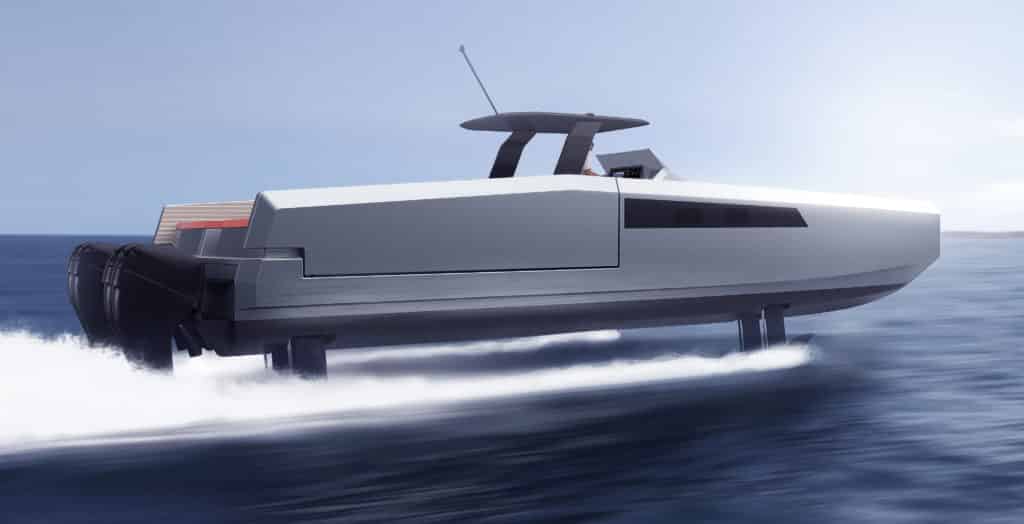
Sunreef is known for pushing the boundaries of catamaran design, incorporating four adjustable hydrofoils into a twin-hulled speedboat.
The Polish builder is one of several European builders (including Evo, Fjord, Wider and Wally) transforming the open day-boat category with creative designs. Beyond its hydrofoils, the 40 Open Sunreef Power ‘s cockpit has side “wings” along the aft gunwales that fold out at anchor, widening the beam from 17 feet to 22 feet 9 inches.
Read more: 40 Open Sunreef Power
Sunreef 50 Amber Limited Edition
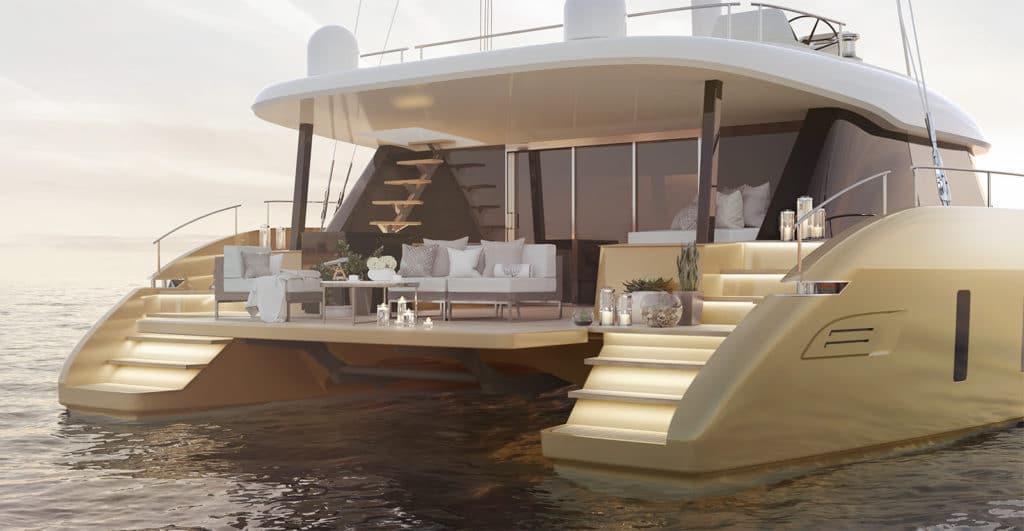
Sunreef Yachts introduced its 50 Amber Limited Edition , with plans to launch just 10 hulls of the exclusive design.
The Sunreef 50 Amber Limited Edition will have a carbon fiber mast and boom, four layout options and numerous amber-colored elements, including the hull.
Read more: Sunreef 50 Amber Limited Edition
Lagoon 630 Motor Yacht
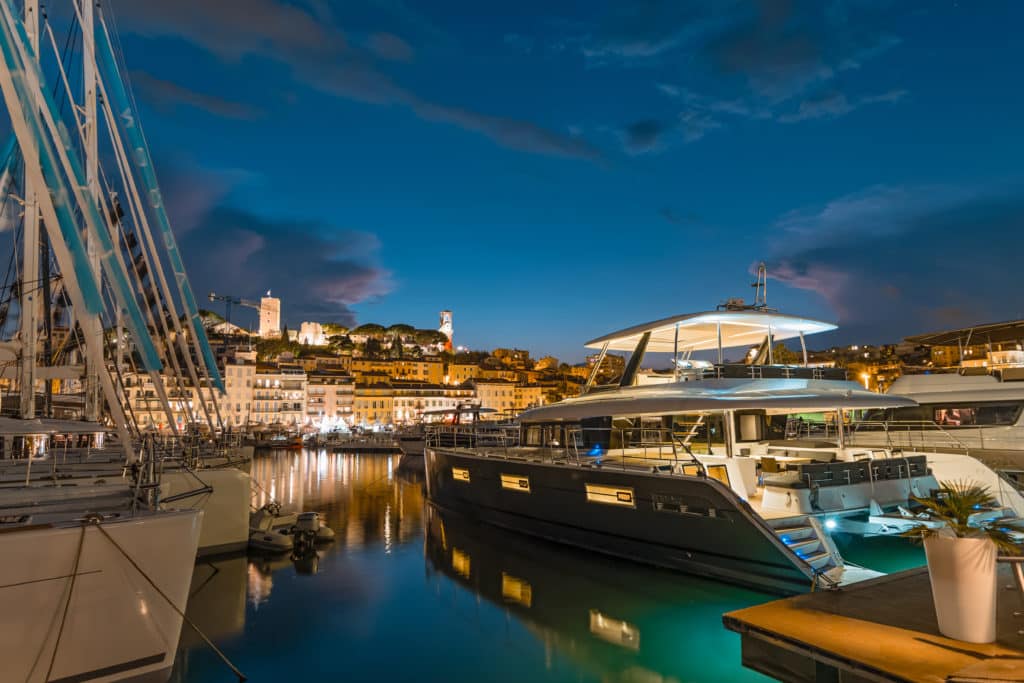
Fitted with the optional twin 300-horsepower Volvo Penta D4 diesels, the Lagoon 630 MY burns only 1.64 gph total at 6 knots, giving a theoretical range of 2,952 nautical miles with standard tankage of 793 gallons. Hull No. 1 had an optional 502-gallon tank, giving it transatlantic range.
Luxury, stability and economy are all hallmarks of Lagoon’s return to luxury motor yachts. If you can take a ride, it will be worth your time.
Read more: Lagoon 630 Motor Yacht
Fountaine Pajot MY 37
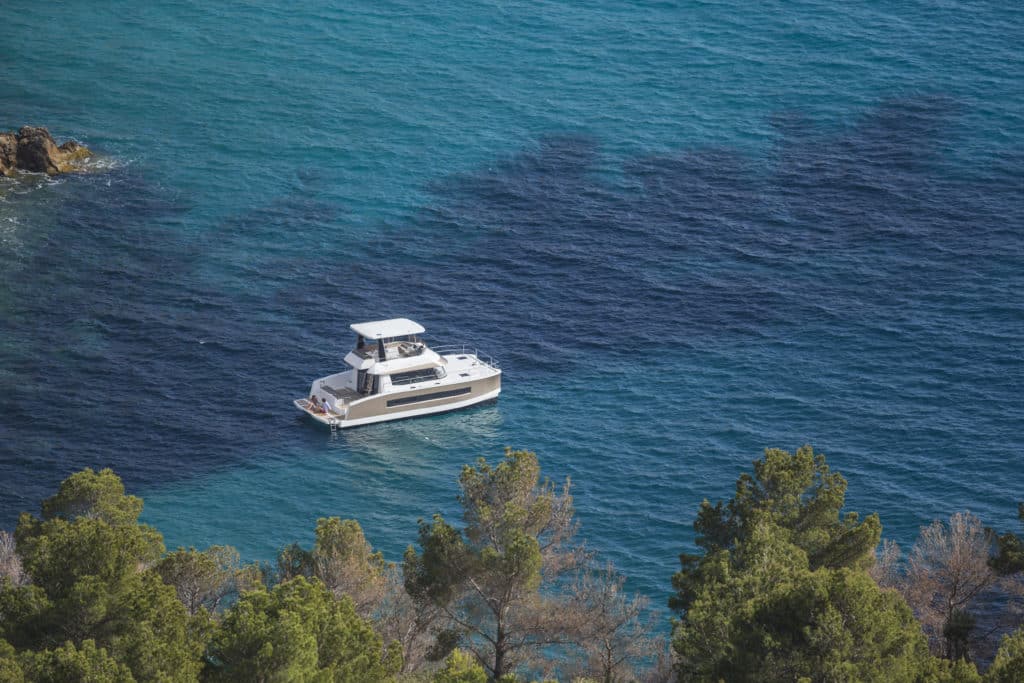
The Fountaine Pajot MY 37 easily accommodates the seafaring family with three- and four-stateroom options. In the three-cabin version, called Maestro, you’ll find an owner’s suite in the portside hull with a queen-size berth and en suite head. Two double-berth cabins and one more head are available for the kids. If your brood is bigger, the Quator setup features four double cabins with two heads.
The 37 is a traveler and can be powered with twin 150 hp or 220 hp Volvo Penta diesels. Top speed with the smaller engines is 17 knots, while it’s 20 knots with the bigger power plants. Interestingly, at 7 knots, the fuel consumption is the same, with either set of motors offering voyagers a 1 ,000-nm range.
Read more: Fountaine Pajot MY 37
Solarwave 64
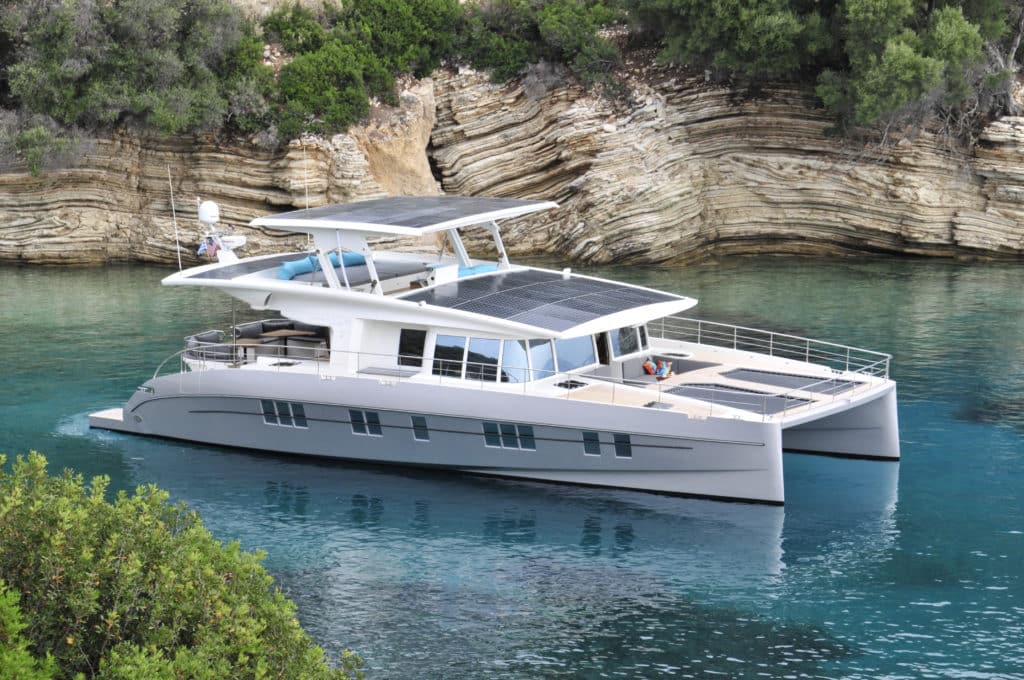
Many yachts boast eco chops because they have a handful of solar panels that power the microwave or navigation lights. The Solarwave 64 , launched last summer, has the potential to run on sunshine alone. The vessel’s 42 solar panels generate 15 kW that are stored in batteries weighing about 1,300 pounds. They connect to electric motors.
Read more: Solarwave 64
Glider SS18
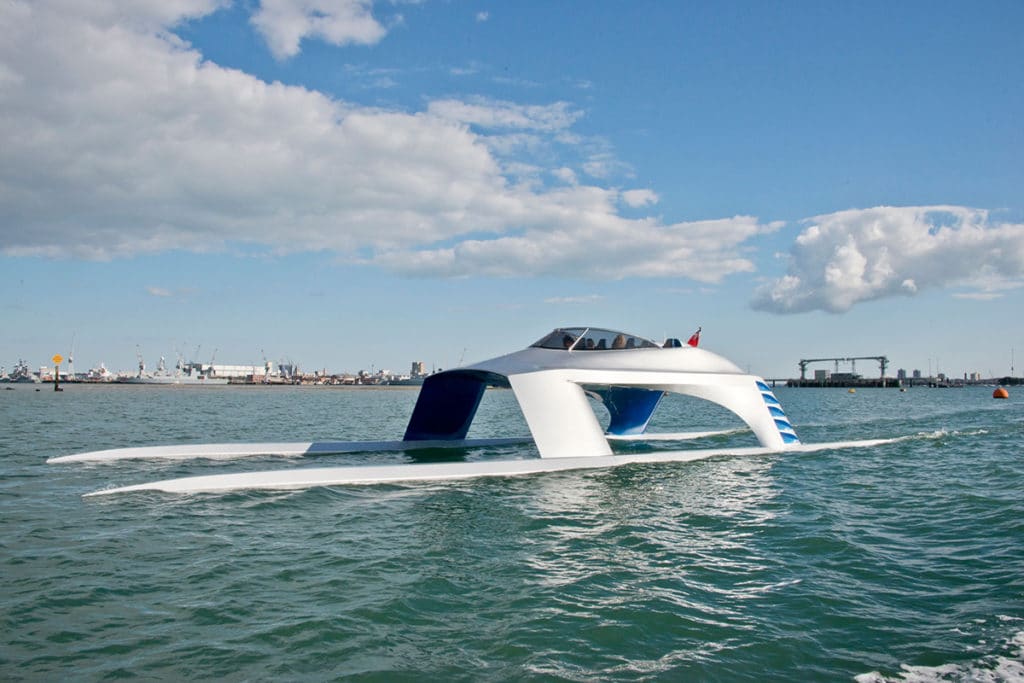
This British builder says it strives for design innovation and the Glider SS18 displays that DNA, the result of 8 years of research and development. She has a head-turning, catamaran hull form constructed from aluminum and composite materials. She is 60 feet LOA with a 17-foot beam, and has a relatively shallow 1-foot draft. Powered by quad Yamaha 300 hp outboards, she can reportedly reach 50 knots, and with her Stability Control System (SCS), should give a smooth ride while doing it.
Read more: Glider SS18
- More: aquila , Aquila Boats , Express and Flybridge Cruisers , Fountain Pajot , Glider Yachts , Horizon Power Catamarans , Lagoon , Power Catamarans , Silent-Yachts , Sunreef , Yachts
- More Yachts
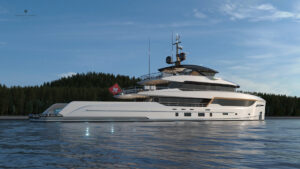
New Flagship for Bering Yachts: The B165
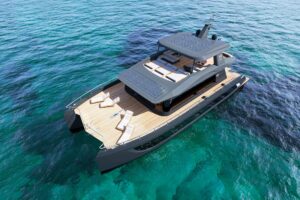
Power Catamaran Popularity Rising
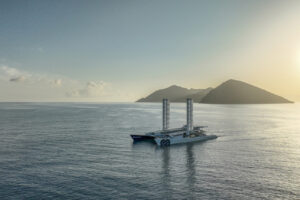
“Energy Observer” Zero-Emission Boat Showcases Sustainability
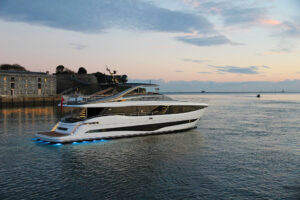
Princess Yachts’ Y95: A Flagship Flybridge
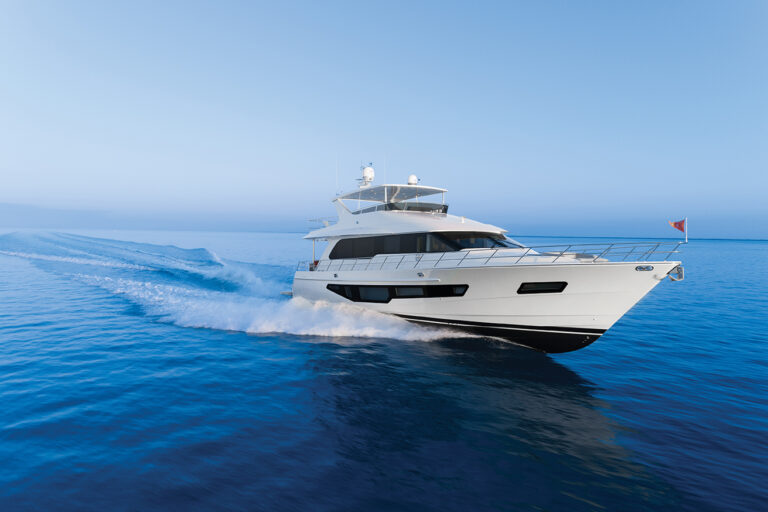
For Sale: CL Yachts CLB 72
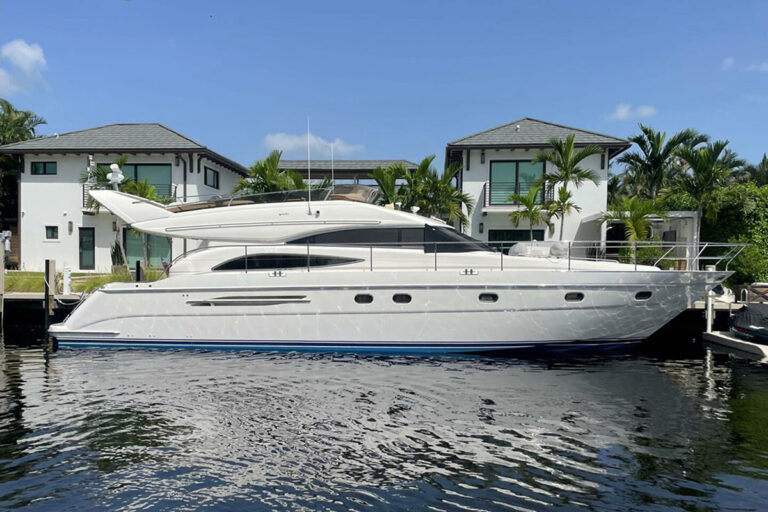
10 Yachts Under $500,000 You Can Have Today
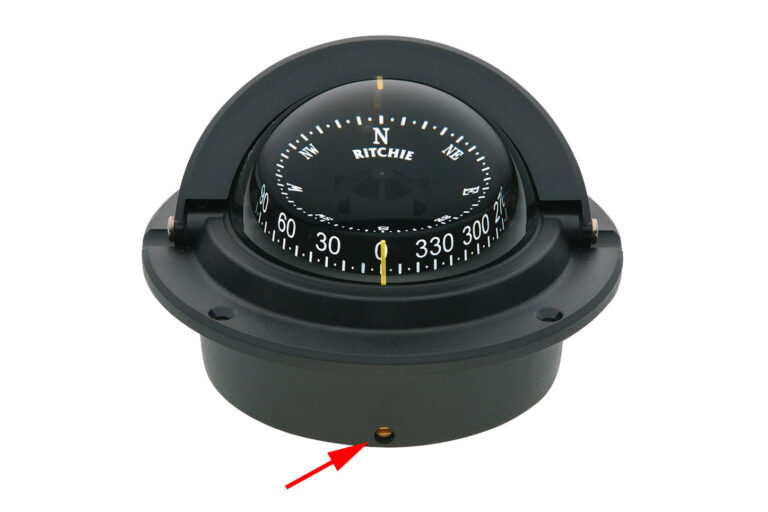
How to Swing a Compass on a Boat
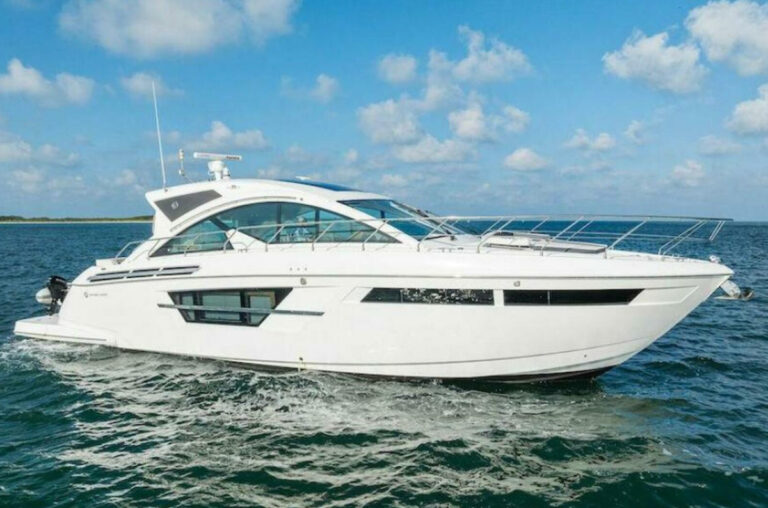
For Sale: 2019 Cruiser Yachts 54 Cantius

- Digital Edition
- Customer Service
- Privacy Policy
- Email Newsletters
- Cruising World
- Sailing World
- Salt Water Sportsman
- Sport Fishing
- Wakeboarding
- BOAT OF THE YEAR
- Newsletters
- Sailboat Reviews
- Boating Safety
- Sailing Totem
- Charter Resources
- Destinations
- Galley Recipes
- Living Aboard
- Sails and Rigging
- Maintenance
- Best Marine Electronics & Technology

Neel 47 Trimaran: Best Full-Size Multihull
- By Herb McCormick
- Updated: December 9, 2019
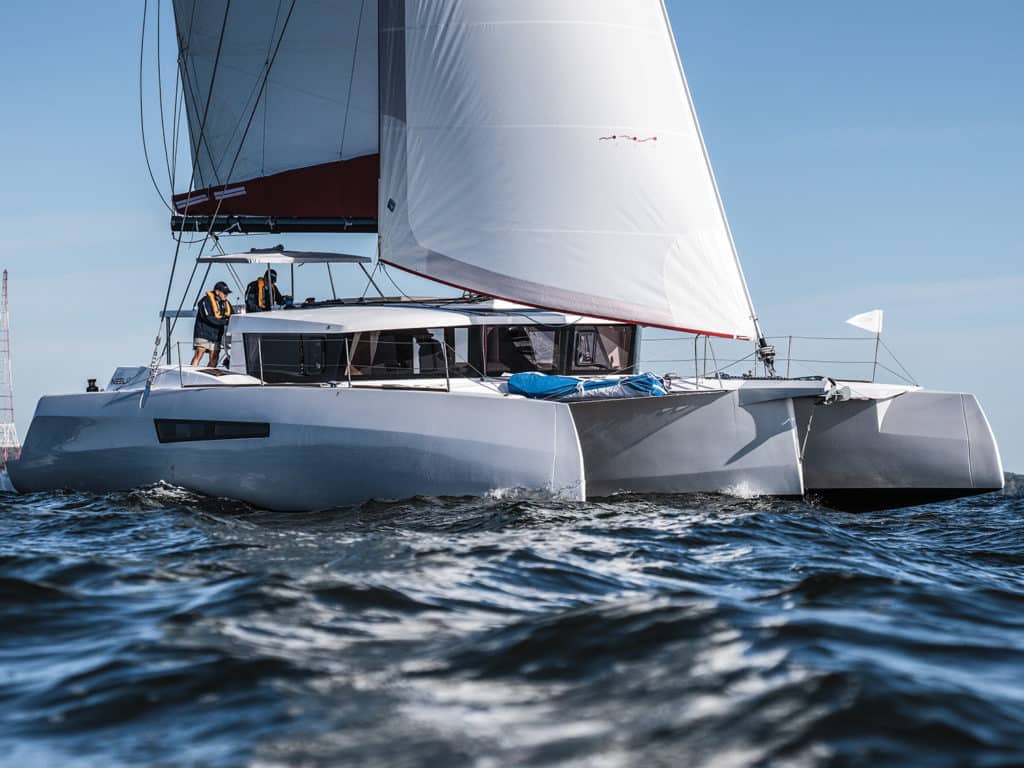
It’s hard to imagine three vessels, in a single class, as different in layout, purpose and execution than the trio of multihulls that comprised the year’s Best Full-Size Multihull class. Two of the three were catamarans, and the third a most unusual craft: a cruising trimaran. Sorting out these unique boats was a challenge.
The multimillion-dollar Eagle Class 53—built in Rhode Island to exacting standards and a radical design brief (with potential foiling capability and a solid wing mast that also incorporates a “soft” mainsail on its trailing edge)—was not, in any manner, a contemporary cruising boat. Yes, there is a pair of cabins with doubles aft, and the central living space includes a workable galley and one other notable feature. “It’s the only boat we sailed that even had a full bar on deck with slide-out seats sitting on carbon fiber: custom-made carbon-fiber pods,” panelist Ed Sherman said. “I mean, it’s just an amazing piece of workmanship. I don’t know what else to say. It’s a cool boat.” And while it would be a reach to call the Eagle 53 a cruiser, it was certainly remarkable and couldn’t be ignored, which is why the judges were unanimous in separating it for special recognition.
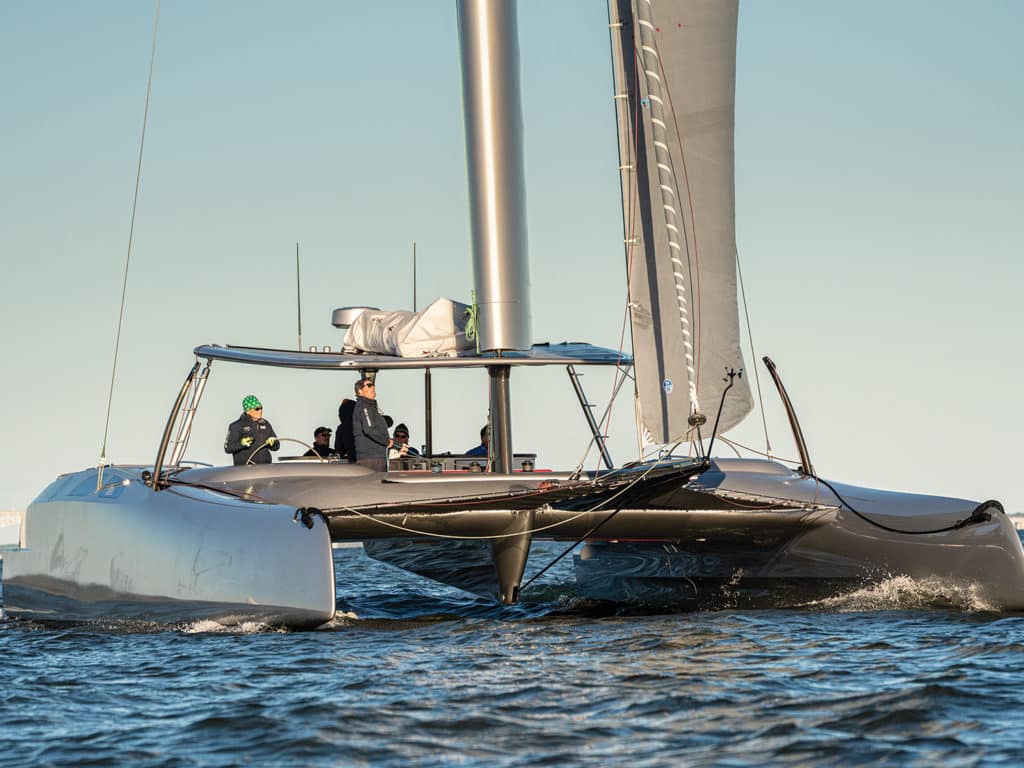
What it thus came down to was which of the two remaining boats—the Bali 5.4 cat and the Neel 47 tri—best addressed or met its stated design briefs. The 55-plus-foot Bali certainly has offshore bona fides—the boats are delivered across the Atlantic from the boatyard in France where they’re crafted—but the yacht is most definitely laid out for steady work (and parties) in the charter trade. The final deliberations were lively.
The first thing that struck judge Dan Spurr was the unusual sailing experience, with the steering station situated on a flybridge well above the waterline. “It felt like a floating island and kind of sailed like one, I thought,” he said. “Being so high above the water, even though we were doing well in light air and making 5 or 6 knots, it was almost hard to tell whether we were moving.”
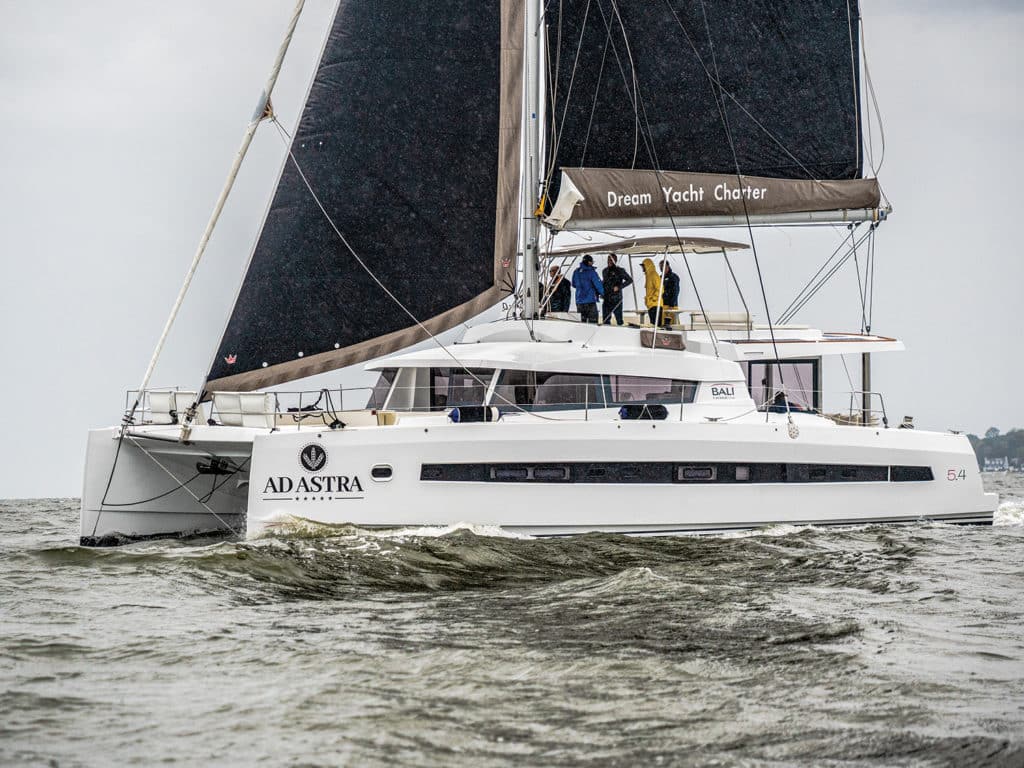
His fellow judge Ralph Naranjo concurred. “The main boom on the Bali is probably 15 or 16 feet high,” he said. “You’re giving away a lot of the foot of the sail, and you’re sticking the masthead up a lot farther in the sky to get the same kind of drive. At anchor in warm climates in areas where you sail flat and don’t have too much of a seaway, boats like this certainly fit the bill. And the Bali was an extreme version of that. The idea of doing an ocean passage up there aloft seems like a tiring situation.”
“Under sail, the motion of the Neel through the water was very comfortable.”
“I was actually pleasantly surprised that the boat sailed better than I thought it would, and by a significant margin,” Sherman said. “And let’s not forget the chartering equation that’s a big part of this boat’s aura. The way it’s equipped and laid out down below, it’s built for calm seas and a bunch of friends to have one hell of a good time.”
In some ways, that describes the reasoning behind what happened next. Viewing it as the better layout and configuration for serious cruising, the judges conferred the title of Best Full-Size Multihull on the Neel 47 . For the BOTY 2020 awards, three hulls proved better than two.
“The Neel 47 is a very interesting boat—the only trimaran in our collection, which has quite a bit of significance just from a design perspective because it enables them to get all of their heavy gear and machinery in that center hull,” Sherman said. “In terms of balance, it’s a great way to go. Under sail, the motion of the boat through the water was very comfortable. It’s a unique concept with the interior layout in that the owner’s stateroom is at deck level with these giant picture windows overlooking the horizon, and the guest cabins are aft and in the amas. So even though we have a 47-footer here, it’s really a couple’s boat, though there is room for occasional guests.”
“The trend of late in cruising multihulls has certainly been toward cats, so I appreciated their efforts to make a cruising trimaran,” Spurr said. “There’s a real trade-off—the fundamental one being I believe you’re going to get better performance with a trimaran, but you’re going to sacrifice accommodations. So I feel that for most of the buying public, they’re going to have to be leaning toward the performance end of the spectrum. The main owner’s cabin on the saloon level is kind of fun and interesting, but it’s adjacent to the galley and entertaining areas. So, I agree with Ed that this is a boat aimed at an experienced couple.”
Those couples who go with a Neel will be going with a winner.
See All Winners:
2020 Boats of the Year
Other Winners:
- Overall Boat of the Year
- Best Performance Cruiser
- Best Midsize Cruiser Under 45 feet
- Best Full-size Cruiser
- Best Full-size Cruiser Over 55 Feet
- Best Midsize Cruising Catamaran
- Best Full-size Multihull
- Best Charter Boat
- Most Innovative
- More: boty , boty 2020 , Sailboats
- More Sailboats

Balance 442 “Lasai” Set to Debut

Sailboat Review: Tartan 455

Meet the Bali 5.8

Celebrating a Classic

Kirsten Neuschäfer Receives CCA Blue Water Medal

2024 Regata del Sol al Sol Registration Closing Soon

US Sailing Honors Bob Johnstone

Bitter End Expands Watersports Program
- Digital Edition
- Customer Service
- Privacy Policy
- Email Newsletters
- Cruising World
- Sailing World
- Salt Water Sportsman
- Sport Fishing
- Wakeboarding

16 Best Trimarans For Sailing Around The World (And a Few For Daysailing)
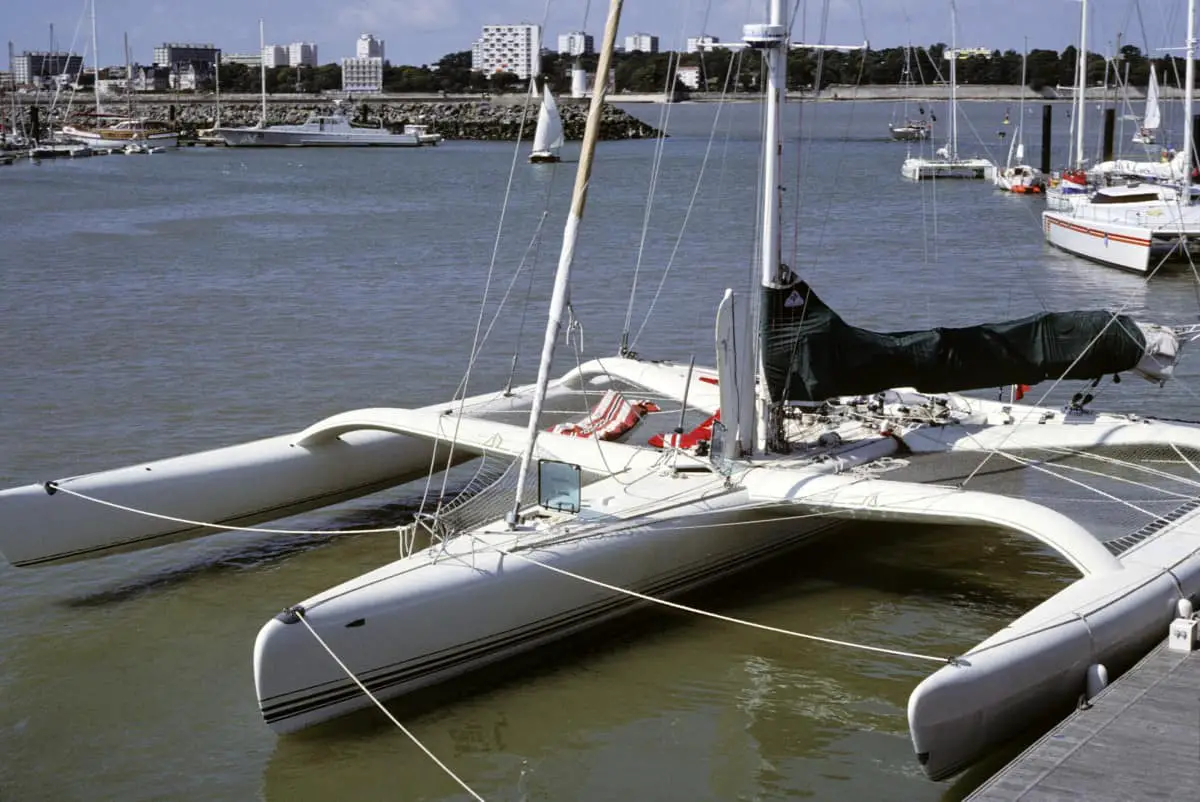
As an Amazon Associate, we earn from qualifying purchases. We may also earn commissions if you purchase products from other retailers after clicking on a link from our site.
Trimarans are growing in popularity worldwide, due to their light construction and high stability these multihulls are even faster than catamarans. Trimarans are still one of the lesser-known boat types so in this article ill be checking out some of the most popular models.
The best trimarans include:
- The Neel 43
- The Neel 47
- Dragonfly 28
- The Pulse 600
- Corsair 37
These tris are built with your safety in mind while also packing powerful speed and a wide array of comfort features to optimize your sailing experience , some are even foldable making them possible to load on a trailer and transport to the sailing destination of your choosing.
In this article, I have created a list of the 16 best trimarans in the market and their unique features. You’ll also learn the best options for different purposes such as circumnavigation, weekend sailing, racing, and more.
Table of Contents
What Is a Trimaran?

A trimaran is a multi hulled sailboat with three individual hulls; the main hull ( vaka ) and a pair of outrigger hulls ( amas ). These smaller outrigger hulls are attached to the main hull using beams.
While trimarans have a rich history dating back nearly four millennia, these types of sailboats have only gained popularity in the late 1900s and early 2000s.
Trimarans are primarily used as personal boats for sailing enthusiasts or racing. These sailboats draw their versatility from their lightweight design, making them faster and easier to handle at sea when compared to single-hulled boats (monohulls). Additionally, the three hulls also contribute to better stability, making it very hard to capsize (although more likely than a cat according to this study)
Trimarans come in various sizes, and some can be as small as 19 feet (5.8 meters) in length, while others go up to 60 feet (18meters). They’re also used for different purposes. Most trimarans are used for racing and recreational purposes, although some units are still used as ferries.
As with all things, to find out which is the best we need to understand what it will be used for. There is a big difference in requirements between a boat used for day sailing compared to offshore around the world sailing.
The list below highlights the best trimarans for different purposes.
Best Trimarans For Cruising, Liveaboard and Sailing Around The World
The Neel 43 is a French trimaran best suited for cruising. Its key features include:
- Easy maneuverability on the open sea by only a small number of crew members
This unit is also built for comfort, ideal for more extended travels. This 43-feet (13-meter) trimaran is also made with recyclable and bio-sourced materials, highlighting the manufacturer’s commitment to environmental consciousness.
This trimaran has a base price of €329,000 excluding VAT. This translates to approximately $370,138.
2.Neel 47 Possibly The Best
Named the best full-size multihull for 2020, the Neel 47 is a strong contender for one of the best trimarans in the market. This 47-foot (14.3-meter) long trimaran features optimized exterior and interior ergonomics for a unique design and look.
Still on design, the Neel 47 is ideal for couples looking to take a weekend off or spend some time as liveaboard. It has a spacious owner’s cabin and two bedrooms. It also features a spacious living room and kitchen and is optimized to ensure comfort for a couple.
The Neel 47 also has two basic guest cabins so your friends or children can tag along on your sailing adventure. Accordingly, this unit is ideal for those looking to explore the sea for the sheer joy of sailing.
The Neel 47 comes at a 571,139 euro ( $643,600 ) price tag, excluding VAT.
3. Rapido 60 The Fast and Comfortable Circumnavigator
The Rapido 60 offers a blend of performance, safety, and luxury, making it one of the best options for bluewater sailing. Measuring 59.3 feet (18 meters) in length, the Rapido 60 is an imposing unit. It’s made from lightweight sandwiches and carbon materials that provide speed and strength, allowing it to stand up to strong ocean currents.
The Rapido 60 also has spacious living spaces and is built for comfort at all points of the sail. Its design also optimizes safety. While it’s an ideal option for circumnavigating, it’s also an excellent choice for racing due to its speed.
This is also the same boat that The Youtube channel La Vagabond just purchased.
The Rapido 60 retails at $1,400,000 .
4. Rapido 40
The Rapido 40 measures 39.4 feet (12 meters) in length and is ideal for cruising around the world. The Rapido 40 features twin “C” foils, which provide added lift, enhancing its speed and performance whether you are sailing downwind or upwind.
Because it has C foils, this trimaran doesn’t have a central daggerboard, increasing interior space. Accordingly, it’s an excellent option for couples looking to cruise and enjoy great performances .
The Rapido 40 is made from high-tech all-carbon materials for a lightweight yet sturdy design. This material is also used for the countertops and furniture, and the cork flooring adds a touch of style.
This trimaran retails for $595,000 , making it a cheaper option than the Rapido 60.
5. Dragonfly 40
The Dragonfly 40 measures 40 feet (12 meters) in length. It features high-comfort standards, making it one of the best trimarans in the market for taking your family for a cruise. Because of its larger size, it has a better capacity, being capable of accommodating six to eight people, so you can bring your family and friends along.
It’s easy to navigate and extremely safe. With a maximum speed of 24 knots (44.5 km/h), this trimaran also provides fast speeds to make your cruise even more exhilarating.
The Dragonfly 40 retails from €509,000 exclusive of VAT, which rounds up to $572,000 .
6. Dragonfly 32
The Dragonfly 32 is a high-performance cruiser. Like the Dragonfly 28, this unit features a contemporary design for racing. This trimaran can accommodate five to seven crew members.
Although slightly longer than the Dragonfly 28 with its 32-foot (9.8-meter) length, the Dragonfly 32 has a max speed of 23+ knots (42.6+ km/h), making it one of the fastest trimarans for racing. This unit also has comfortable accommodation, which makes it an ideal option for a weekend cruise with family and friends.
The Dragonfly 32 has a base price of $350,000 .
7. Corsair 37
Thanks to a variable draft with a retractable rudder, the Corsair 37 is an ideal choice for shallow water exploration. This 37-foot (11.3-meter) long trimaran features advanced foam-cored construction designed for safety, making it virtually unsinkable.
The carbon hulls minimize weight, this makes for a lightweight ocean exploration sailboat with blistering speeds. One of its selling points is that this trimaran has previously been used for Arctic expeditions, possibly marking it as one of the better options for circumnavigation and offshore sailing in the northern waters.
This trimaran has a base price of $189,000 but can go up to $204,125 .
Best Trimarans For Day/Weekend Sailing
8. dragonfly 28.
The Dragonfly 28 is a 28-feet (8.75-meter) long sailboat that can accommodate up to five people. It comes in two versions:
- Touring version: This version is ideal for families.
- Performance version: This is built to provide optimal performance for the sports enthusiast within you.
It clocks a maximum speed of 22+ knots (22+ km/h) and is beam-folded. It’s an excellent option if you want a high-performance, comfortable yet smaller unit for your day or weekend cruise.
The Dragonfly 28 starts at €188,280 inclusive of VAT, which comes to around $211,600.
9. Dragonfly 25
Like other trimarans under the Dragonfly brand, this 25-foot (7.62-meter) trimaran is great for both racing and short term cruising. However, this high-performance boat delivers easy handling, making it perfect for couples looking to take a ride out over the weekend and seasoned sailors looking for an exhilarating racing adventure.
The Touring version features a lightweight build and offers comfort and accommodation to keep you, and the few guests you can fit, comfortable during the ride. This trimaran also has a Sport version, which is optimized for racing.
The Dragonfly 25 retails from EUR 86,800 .
10. Pulse 600
The Pulse 600 trimaran is a compact sailboat. It’s made from lightweight, carbon-reinforced construction and vacuum-formed materials for optimal speed. This trimaran is an ideal option if you are looking for speed.
It also features ample deck space, greater stability, and volume than most trimarans of similar size and build.
This trimaran measures 19.8 feet (6 meters) in length and can be sailed single-handedly by one person with minimal effort. The Pulse 600 has a base price of $38,800 , which places it in the lower price range.
The F-22 is one of the smaller trimarans in the market. Developed in New Zealand, the F-22 is a folding trimaran built for speed. The hulls are made from narrow fiberglass tied together using fiberglass beams and aluminum, minimizing bulk while optimizing speed.
The F-22 is roomy and is not as pricey as other models in the market. This trimaran has two main versions:
12. 2019 Weta Trimaran
The 2019 Weta trimaran is a 14.5-foot (4.4-meter) trimaran featuring a carbon frame, centerboard, rudder foil, and rudder shock. The hull is made from fiberglass and foam. The Weta is built for strength and speed based on these lightweight materials.
The 2019 Weta trimaran is easy to sail and is worth considering whether you want to take a quiet sail, race with your friends, or take kids to a sailing lesson. It has a simple design and is easy to set up independently. Thanks to its collapsible design, this trimaran is easily stored away with minimal space demands.
13. WindRider 17
The 17.4-foot (5.3-meter) WindRider 17 is one of the more versatile trimarans in the market. It packs high performance for a low cost. This trimaran has a light rotating mast to boost performance, and a full-battened mainsail optimizes visibility.
This sailboat is made from rotomolded polyethylene, which is more durable than fiberglass and demands less maintenance.
The WindRider 17 has a comfortable interior and can fit six adults. This is an ideal choice for social sailing for a couple or a family and friends. It’s easy to ride, and a shallow draft allows easy maneuverability.
14. Astus 22.5
If you’re looking for something small but still comfortable, this 22.5-foot trimaran is for you. Built for speed and maneuverability, the Astus 22.5 has optional foils to optimize speed. The modern design, coupled with the spacious interior, can fit up to four beds. Accordingly, this trimaran is suited for family outings.
This trimaran also has a foldable design, collapsing to only 16 feet (4.9 meters) for easy storage.
15. Multi 23 Trimaran
The Multi 23 trimaran has a contemporary design, featuring a vinyl ester and PVC foam core construction. The section below the waterline is made of solid glass for a sturdy base.
The beams are made of lightweight carbon, and the trimaran features a 33-foot (10-meter) aluminum rotating wing mast for optimal harnessing of the wind. While ideal for weekend excursions with family, once rigged with the asymmetrical spinnaker will get your heart pumping.
This trimaran packs high performance at a lower cost than most other options in the market. It’s a good choice if you are looking for a high-performing unit without spending an arm and a leg.
16. Challenger Class Trimaran
The Challenger Trimaran 15 is the best choice for persons with disabilities. It’s designed to provide disabled sailors an opportunity to explore their passion for sailing without worrying about aspects like safety or operation.
A man named Geoff Hold circumnavigated the British Isles in 2007, becoming the first disabled person to achieve this feat. He had quadriplegia.
Living up to its name, the Challenger can withstand harsh weather conditions while blending performance with speed.
Final Thoughts
Admittedly, no trimaran is best for everyone. But whether you are looking to race with your friends, take your loved ones or friends for a cruise over the weekend, or circumnavigate the ocean, you can rest assured that these lightweight trimarans will deliver speed, safety, and comfort to make it worth your while.
These brands are innovatively designed and feature intricate safety mechanisms that make them virtually unsinkable. Give them a shot and begin your ocean adventure.
- Basco Boating: A Comprehensive Guide & Introduction to Trimaran Yachts
- TheBoatAPP: New Trumarans: Which are the Best Ones
- Corsair Marine: Corsair 37
- Dragonfly: Dragonfly 28
- Rapido Trimarans: Rapido 60
- Neel Trimarans: Neel 43
- Yachting World: World’s Collect Yachts: Maxi Trimaran MACIF
- Yachting Monthly: Dragonfly 28 Performance
- Rapido Trimarans: Rapido 40
- Dragonfly: Dragon 32
- Dragonfly: Dragonfly 40
- Yachting World: Dragonfly 40 yacht tour: This cruising trimaran can do 24 knots
- Dragonfly: Dragonfly 25
- NauticExpo: Dragonfly 25
- Yachtworld: Corsair 37 boats for sale
- Cruising World: Neel 47 Trimaran: Best Full-Size Multihull0
- Neel Trimaran: Neel 47
- Multihull Solutions: NEEL 47 Boat Review | Cruising World
- Yacht World: 2022 Neel 47 for sale
- Farrier International: F-22
- Weta Marine: The Boat
- WindRider: WindRider 17 Trimaran Sailboat
- Astus Boats: Astus 22.5
- Boat-specs: Multi 23
- National Maritime Museum Cornwall: Challenger Trimaran #1 – BC26
Owner of CatamaranFreedom.com. A minimalist that has lived in a caravan in Sweden, 35ft Monohull in the Bahamas, and right now in his self-built Van. He just started the next adventure, to circumnavigate the world on a Catamaran!
Leave a Reply Cancel reply
Your email address will not be published. Required fields are marked *
Save my name and email in this browser for the next time I comment.
Recent Posts
Must-Have Boat Gear for Catamaran Sailors!
Sailing is probably the most gear-intensive activity I've ever done; there are so many decisions to be made about what gear to buy now, for tomorrow, and what to definitely never buy. The gear on...
6 Best Trailerable Trimarans For Bluewater and Coastal Sailing
Having a boat costs a lot of money, even when you are not using it, marina fees, etc. And once it is in the water most sailors never go very far from their "home marina" and sailing will be somewhat...

Are Catamarans Safe For Ocean Crossing?

Last Updated by
Daniel Wade
June 15, 2022
Catamarans aren't the most common ocean-crossing sailboats, but they're surprisingly safe and capable offshore.
Catamarans are safe for ocean crossings. In fact, catamarans are often much safer than similarly-sized monohulls offshore. Safety comes from increased motion comfort, great stability, speed, and excess buoyancy due to lack of ballast.
In this article, we’ll examine if catamarans are safe (or safer) than monohulls for offshore cruising and ocean passages. We’ll also examine the benefits of cruising catamaran design, along with how these vessels handle in different offshore conditions.
We gathered the information used in this article from offshore sailing guides and reputable catamaran experts. We also examined design guidelines for offshore cruising boats, including head-to-head tests done between catamarans and other vessels.
Table of contents
Safety of Bluewater Catamarans
Cruising catamarans that are capable of bluewater sailing are some of the safest vessels on the water. In fact, they're often preferred for ocean crossing due to their miraculous speeds and excellent rough-water handling qualities.
Catamarans are uniquely equipped for safe and comfortable offshore sailing. They're not subject to the traditional limitations of hull speed, and they have a mild planing effect which reduces drag and the effects of rough seas.
Safest Catamaran Design for Crossing an Ocean
The safest ocean-crossing category is cruising catamarans, as these vessels include design elements and safety features that aren't found in recreational racing catamarans. An example of this is additional positive buoyancy material and watertight hatches.
Cruising catamarans have high-strength cockpit windows, which are designed to resist damage if a wave crashes on them. They also have redundant systems such as bilge pumps, navigation lights, and radios—which are all essential in an offshore voyage.
In fact, cruising cats are so safe that they're often recommended by expert sailors to more novice individuals. They aren't necessarily easier to sail, but they can handle rough weather safely and with better stability.
This keeps the crew dry and rational while the boat handles much of the ocean's beating all on its own.
Is it Safe to Sail a Catamaran During the Winter?
Catamarans can actually be safer to sail in winter weather conditions than monohulls. This is because cruising catboats almost always have enclosed cockpit spaces that are completely shielded from the elements. This is particularly helpful during the winter, but it's also a great feature in the tropical rainy season.
Catamaran crews can usually pilot their vessels from inside or behind these enclosed cockpits, keeping them warm and dry for as long as possible.
Additionally, given the premium nature of cruising catamarans, many of these vessels have automated winches and sails, allowing complete control from the interior cockpit.
How do Catamarans Handle Rough Weather?
Catamarans handle rough weather well, especially larger vessels with more displacement. But unlike monohull sailboats, draft and displacement aren't the most critical factors when evaluating foul-weather safety.
Catamarans are more difficult to swamp than monohulls. This is because they create a channel between their hulls that acts as a pressure relief valve, thus decreasing the likelihood of a rogue wave pushing the vessel under or knocking it over.
Catamarans are famous for their ability to weather high winds and chop. An equal-sized monohull may be just as strong and seaworthy, but the crew certainly wouldn't be praising its easy-riding qualities after a strong storm.
Catamaran captains are sometimes guilty of underestimating the danger or intensity of storms because a storm that beats the confidence out of a monohull crew may not even spill the coffee off the galley table in a catamaran.
Catamaran Buoyancy
Catamarans also have design elements that make them difficult—or nearly impossible—to sink. Or, to sink completely anyway. It's all about buoyancy, and catamarans have tons of it.
Monohull sailboats can handle well offshore, provided they have a low enough center of gravity and enough displacement to stay upright in violent gusts and large waves. Usually, monohull designers achieve this by working in an extremely heavy and deep ballasted keel.
In other words, offshore monohulls sit artificially low in the water due to added ballast for stability, both inside the cabin and deep in the keel. This is great until something starts to throw off-balance, like a bunch of water in the cabin.
Catamarans don't sit very low in the water because they're much more buoyant than monohulls and carry no large keels or ballast.
On their own, catamaran side hulls would probably roll over due to their lack of low ballast. But when strung together, they balance each other out and keep the hull far out of the water.
Catamarans don't often sink because they're simply too buoyant. They use their width and dual hulls to make up for the lack of ballast.
Plus, catamaran builders sometimes add additional positively buoyant material such as foam, to the point where sinking an intact vessel would be utterly impossible.
Are Catamarans Strong Enough for Ocean Sailing?
All production bluewater catamarans are extremely rigid and structurally sound. Catamarans make ocean journeys all the time and suffer tremendous stresses, which monohulls never experience. As a result, they're built using stronger materials and reinforced in all necessary areas.
Do Catamarans Break in Half?
It seems easy enough to believe—a catamaran hits a funny wave and breaks in half. After all, catamarans are only held together by a thin strip of fiberglass, right? Wrong—catamaran design is very robust, and all production catamarans are thoughtfully designed and strong.
Apart from the odd story in a sailing magazine, catamarans rarely just break in half. There have been some cases of it happening, but only due to extreme conditions, specific design flaws, or shoddy amateur construction.
Catamarans hulls break off far less often than regular monohulls sink—often in much less hazardous conditions than the few catamarans that did break in this way. So no, you don't have to worry about a production catamaran breaking in half while on the ocean.
Catamaran Comfort and Safety
Comfort can actually be a safety benefit on the open ocean, especially when sailing with a limited crew. Catamarans are known for their stability and increased motion comfort, which can improve the overall health and ability of the crew.
Think about it this way. A seasick and exhausted crew won't be able to deal with navigation or emergencies as efficiently and safely as a well-fed and well-rested crew. This is one of the indirect benefits that offshore catamarans have above most traditional monohull designs.
Catamaran Roll Safety
What happens if a catamaran suffers a knockdown? Usually, nothing good—catamarans can't self-right after a knockdown, unlike some monohulls with a low center of gravity. You're much more likely to have a knockdown or nail-biting roll on a monohull than a catamaran.
That said, catamarans don't suffer knockdowns nearly as easily as similarly-sized monohulls. This is because catamarans distribute their weight widely, and they have a much greater natural roll resistance.
Catamarans have great buoyancy in some parts of the hull and minimal buoyancy in others, which can actually increase roll resistance. For example, catamarans can slice through waves instead of riding over the crest and rolling violently.
It's not easy for the wind to push a catamaran down—quite the opposite. Catamarans actually rise out of the water slightly when sailed properly, even at angles perpendicular to the wind. Catamarans tend to increase in speed as wind speeds increase, directing more energy forward instead of to the side.
Monohulls have completely different high-wind handling characteristics. At some wind angles, high winds can push a monohull dangerously to one side. This is distinct from normal heeling, as the water can begin to rush over the deck and swamp the single-hull vessel.
Can Catamarans Survive Flooding?
Catamarans benefit from another safety feature that's not necessarily a design choice but a design element nonetheless. Catamarans are essentially compartmentalized, and they have a center cockpit high above the waterline.
These characteristics increase the amount of flooding necessary to seriously endanger the vessel. For example, a small leak in one hull needs to be fixed promptly—but it doesn't endanger the boat nearly as much as the same leak in your only hull.
Additionally, much of a catamaran's interior space is in the center console, which is above the waterline and thus can't be flooded from the hulls. Or at least not immediately. This is one of the reasons why catamarans rarely sink.
Catamaran Safety Equipment
Catamarans have a large amount of flat, open space between the hulls. These areas are useful for stowing equipment such as high-tech covered life rafts.
A small boat may have to make do with a small life raft and limited emergency supplies, yet a catamaran can store safety equipment for much larger vessels.
Catamaran Speed
Speed is an important and often overlooked aspect of safety, and we can use an example to demonstrate why. Picture two boats somewhere between Florida and the Bahamas. Dark clouds begin to form overhead, indicating a possible afternoon thunderstorm.
Boat A is a catamaran with good speed and sea keeping abilities. Boat B is a heavier monohull of the same length but greater displacement and technically better seaworthiness.
The catamaran, Boat A, deploys full sail and makes a speed of about 15 knots to outrun the forming storm. Boat B is a monohull and can't make more than 8 knots, even in the best conditions.
Boat A makes it back to port with time to spare, but Boat B is well out to see taking a beating from the storm. Speed means safety in many situations, even though it's never smart to try and beat the weather if you can stay in a safe location instead.
Related Articles
Are Catamarans More Stable?
Are Catamarans Good In Rough Water?
Are Catamarans Safer than Monohulls?
I've personally had thousands of questions about sailing and sailboats over the years. As I learn and experience sailing, and the community, I share the answers that work and make sense to me, here on Life of Sailing.
by this author
Learn About Sailboats
Most Recent

What Does "Sailing By The Lee" Mean?
October 3, 2023

The Best Sailing Schools And Programs: Reviews & Ratings
September 26, 2023
Important Legal Info
Lifeofsailing.com is a participant in the Amazon Services LLC Associates Program, an affiliate advertising program designed to provide a means for sites to earn advertising fees by advertising and linking to Amazon. This site also participates in other affiliate programs and is compensated for referring traffic and business to these companies.
Similar Posts

Affordable Sailboats You Can Build at Home
September 13, 2023

Best Small Sailboat Ornaments
September 12, 2023

Discover the Magic of Hydrofoil Sailboats
December 11, 2023
Popular Posts

Best Liveaboard Catamaran Sailboats
December 28, 2023

Can a Novice Sail Around the World?
Elizabeth O'Malley

4 Best Electric Outboard Motors

How Long Did It Take The Vikings To Sail To England?

10 Best Sailboat Brands (And Why)
December 20, 2023

7 Best Places To Liveaboard A Sailboat
Get the best sailing content.
Top Rated Posts
Lifeofsailing.com is a participant in the Amazon Services LLC Associates Program, an affiliate advertising program designed to provide a means for sites to earn advertising fees by advertising and linking to Amazon. This site also participates in other affiliate programs and is compensated for referring traffic and business to these companies. (866) 342-SAIL
© 2024 Life of Sailing Email: [email protected] Address: 11816 Inwood Rd #3024 Dallas, TX 75244 Disclaimer Privacy Policy

IMAGES
VIDEO
COMMENTS
Lagoon 380. The long-time best-seller from the world leader in catamarans, with more than 1,000 produced over almost 20 years from 1999. With its characteristic vertical windows, the 380 and its ...
The best catamarans for sailing around the world include: Lagoon 42. The Fountaine Pajot Ipanema 58. Manta 42. Catana 50. Dolphin 42. Gunboat 62. These cats focus on speed, safety, and comfort for longer journeys. This article will show you the seventeen best catamarans for long journeys, and why they're the best.
The best catamaran sailboats can easily clock 250-mile voyages, offer incredible performance, and have layouts that can be easily optimized for individuals, charter markets, and great accommodation. In essence, the best catamaran sailboats offer respectable performance and offer good load-carrying ability. ... ocean-going capabilities, and ...
Here's a list of the Top 15 best Multihulls reviewed in this article: Leopard Catamarans - 41 ft 7 in - Leopard 42. Balance Yachts - 48 ft 26 in - Balance 482. Kinetic Catamarans - 54 ft 2 in - Kinetic KC54. Xquisite Yachts - 53 ft - Xquisite X5.
So today we are going to present our choice based on the criteria mentioned above. One of the best catamarans for ocean sailing in 2020 is The Privilege 435. This is a long-distance, light weight cruiser produced in the Gold Coast area of La Rochelle. The Privilege 435 is a heavy-displacement multihull that has been around for almost 30 years.
1) Lagoon 42 sailing catamaran - From $365,000. Features: Self-tacking jib, 3 or 4 cabins layout, island bed in the master cabin, 6 to 12 berths, up to 4 heads, 2 45hp engines, up to 4 heads, 300L water capacity, 300L fuel capacity. If you value comfort over speed, then the Lagoon 42 is the best sailing catamaran for you.
The best naval architects and designers have been able to work in complete freedom to achieve the ideal compromise between quality of life, performance and sailing comfort, all combined into one ocean-going catamaran. The Outremer 55, a 55-foot liveaboard catamaran, is easy to maneuver, whether short-handed or even solo.
The best production blue water cruising catamarans are the Manta 42, the Lagoon 42, the Leopard 45, the Lagoon 450, and the Prout 45. These vessels have excellent living accommodations and great sea keeping abilities. In this article, we'll cover five of the best liveaboard cruising catamarans, along with what sets them apart from similar ...
Best bluewater cruisers of 2022. The new flagship Allures 51.9, for example, is a no-nonsense adventure cruising design built and finished to a high standard. It retains Allures' niche of using ...
Gunboat 62. Gunboat 62 Courtesy of Gunboat. Built between 2000-2005, the Gunboat 62 firmly established the Gunboat brand: go-anywhere cats that applied race-boat technology to a world-cruising platform. Hull no. 1, Tribe, was built for company founder Peter Johnstone, who then spent a year-and-a-half cruising with his family, smiling all the way.
2022 Boat of the Year: Best Performance Catamaran. Quick, fast and fun, the South African-built Balance 482 is a cat that will get up and go, but offers plenty of comfort once the hook is down. By Cruising World Editors. December 15, 2021. During and in the four days immediately following the US Sailboat show in Annapolis, Maryland, the ...
Arcona 435. The Performance Cruiser winner at the 2019 European Yacht of the Year awards, the Arcona 435 is all about the sailing experience. She has genuine potential as a cruiser-racer, but her ...
The Trade Winds route is the classic itinerary followed by most ocean-going catamarans. It promises crews the chance to sail around the world pushed by the wind, downwind, as long as they follow the rhythm of the seasons. It's possible to sail a catamaran from east to west, crossing three oceans and stopping off at some fantastic destinations.
You can spec your boat with either mini keels (OC or "ocean cruising") or daggerboards (SC or "sport cruising"). The HH50 is the company's best bet for circumnavigating with a small family. There's also the capable, smaller sistership, the HH44. BOAT TOUR with OWNER - HH50-SC Synergy | Luxury Performance Catamaran.
The Aquila 36 is the first vessel in the builder's series with outboard power. Aquila Boats. The Aquila 36 is a departure from her sisterships in that she is an outboard-powered, express-cruiser-style catamaran, but she also adheres to MarineMax's philosophies.. With a single main living level from bow to stern and a beam of 14 feet 7 inches, the Aquila 36 is like a bowrider on steroids.
Leen 56. The Leen 56 power trimaran is a long-range cruising multihull, perfectly capable of transatlantic voyages or living aboard in high latitudes. Built in a highly efficient, new hybrid composite panel system, this power trimaran has a range of 5,000 miles and may only be fueled up once a year. 3. Gallery.
Nautitech 47 Power. Horizon PC74. Lagoon Seventy 8. ArrowCat 420. Bali 4.1. Sunreef Supreme 68. Hudson 48. In this article, I'll review some of the best power catamarans out there. I'll also go over the main features of different power cats and if they can handle rough weather.
The Atlantic Ocean, for example, is a journey of 3,000 nautical miles, so you'll want to ensure the yacht you are using to cross it is a sturdy, ocean going vessel. Many superyachts will make the Atlantic Ocean crossing twice a year - in the fall to head to the Caribbean, and in the spring to return to the Mediterranean.
The perfect sized catamaran for ocean sailing (including around the world sailing) is around 40ft; it is small enough to be sailed by one person but big enough to provide safety and speed. Of course, there are many variables to consider, and below we will discuss many of them. Before we can decide which one is perfect for our needs, we need to ...
Cruising World Judges named the Neel 47 trimaran the Best Full-Size Multihull for 2020. In the large multihull class, at least for 2020, the Neel 47 proved that three hulls are better than two. The Eagle Class 53 was easily the most unique boat in the long history of Boat of the Year. Jon Whittle. It's hard to imagine three vessels, in a ...
Built by a wide variety of yacht makers, there are currently 1,800 catamaran yachts for sale on YachtWorld, with 438 new vessels for sale, and 1,362 used and custom yachts listed. These vessels are all listed by professional yacht brokerages and new boat dealers, mainly in the following countries: United States, France, Croatia, Italy and Greece.
This trimaran retails for $595,000, making it a cheaper option than the Rapido 60. 5. Dragonfly 40. The Dragonfly 40 measures 40 feet (12 meters) in length. It features high-comfort standards, making it one of the best trimarans in the market for taking your family for a cruise.
June 15, 2022. Catamarans aren't the most common ocean-crossing sailboats, but they're surprisingly safe and capable offshore. Catamarans are safe for ocean crossings. In fact, catamarans are often much safer than similarly-sized monohulls offshore. Safety comes from increased motion comfort, great stability, speed, and excess buoyancy due ...